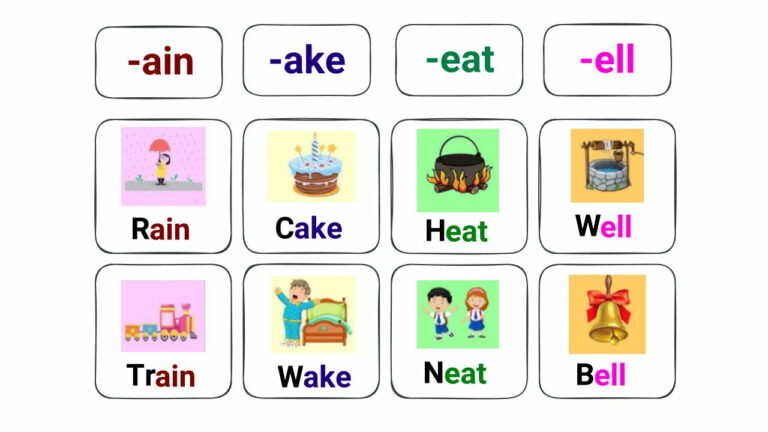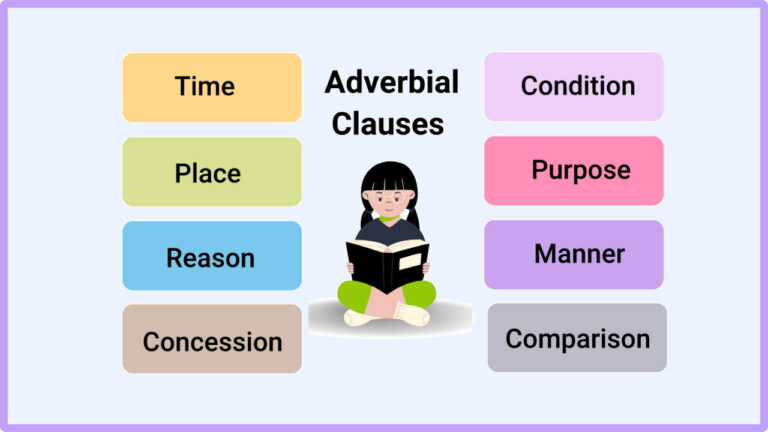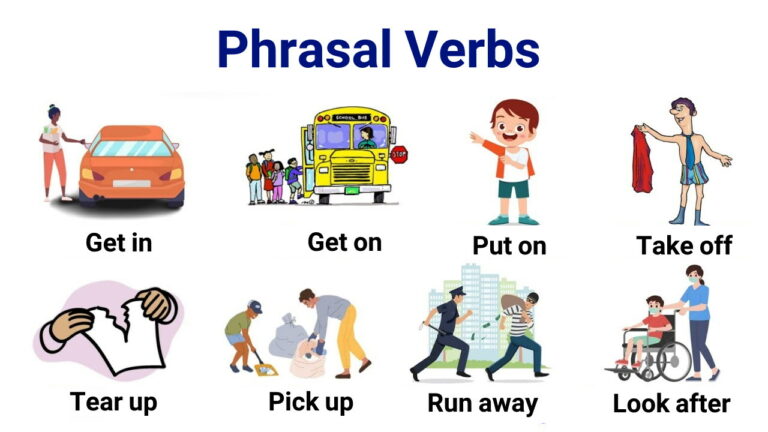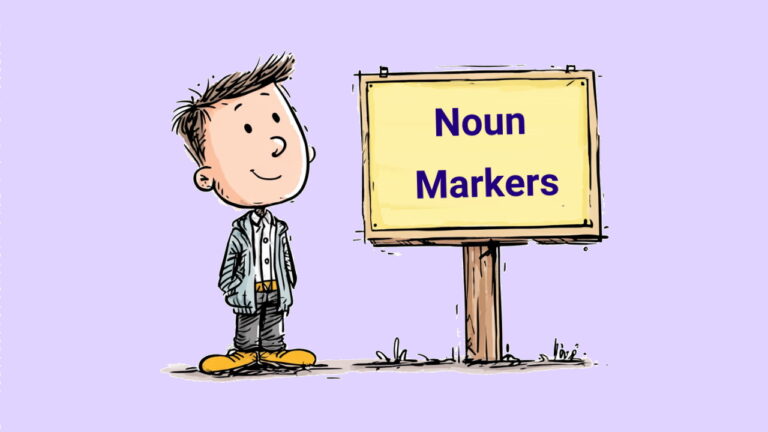چگونه Essay بنویسیم؟ – آموزش نحوه نوشتن Essay به انگلیسی
«Essay» نوعی متن آکادمیک است که با عنوانها و موضوعات مختلفی مطرح میشود. درواقع موضوعی از شما خواسته میشود که بر اساس آن باید نوشته خود را در قالب متنی با تعداد کلمات مشخص ارائه دهید. اما برای اینکه «essay» بنویسید، باید با اصول و قوانین آن آشنا شوید. یکی از این موارد، نحوه پاراگرافنویسی در انگلیسی است. برای این منظور باید با ساختار هر پاراگراف آشنایی کامل داشته باشیم و بدانیم که برای هر «essay» لازم است چند پاراگراف بنویسیم. همچنین باید با توجه به موضوعی که در اختیار داریم، نوع پاراگراف و اجزای آن را مشخص کنیم. هر پاراگراف از جملاتی تشکیل شده که بر این اساس «essay» شکل میگیرد. ازطرفی، قبل از نوشتن، باید ایدهپردازی کنیم تا طرح کلی در ذهنمان نقش ببندد و سپس متن خود را به نگارش دربیاوریم. در این آموزش از مجموعه آموزشهای زبان انگلیسی «مجله فرادرس» یاد میگیریم که چگونه Essay بنویسیم و چطور اجزای مختلف یک پاراگراف را ایدهپردازی کنیم و به روی کاغذ بیاوریم. بنابراین، موضوعاتی مانند نحوه نوشتن پاراگراف و طرحریزی نوشته را بررسی خواهیم کرد. همچنین متنهایی را در اختیار شما قرار میدهیم تا بتوانید به عنوان نمونه از آنها استفاده کنید. در انتهای مطلب نیز میتوانید جمعبندی کلی از این مطلب را مطالعه کنید.
- میآموزید Essay چیست و چه نقش مهمی در مهارتهای نوشتاری دارد.
- با انواع مختلف Essay در زبان انگلیسی و ساختار هرکدام آشنا میشوید.
- میتوانید مراحل آمادهسازی و نوشتن Essay را بهدرستی انجام دهید.
- اصول پاراگرافنویسی و نکات کلیدی برای نوشتن پاراگراف منسجم را یاد میگیرید.
- اهمیت استفاده صحیح از علائم نگارشی در نوشتن Essay را میآموزید.
- اشتباهات رایج در نگارش Essay انگلیسی را میتوانید تشخیص دهید و اصلاح کنید.


چگونه Essay بنویسیم ؟
نوشتن Essay به انگلیسی معمولاً یکی از چالشهای زبانآموزان است و در برخی موارد به دغدغه بزرگی برای آنها تبدیل شده است. واقعیت این است که نوشتن Essay فقط برای افرادی که مشغول یادگیری زبان انگلیسی هستند، دشوار نیست؛ برای افراد انگلیسیزبان نیز امری چالشبرانگیز است و به همین دلیل تمام دوران دبیرستان در کلاسهای درسی خود، به شکلی تدریجی تمام مراحل نوشتن آن را میآموزند.
برای اینکه بدانیم چگونه Essay بنویسیم، لازم است ابتدا با مفهوم آن آشنا شویم. «essay» به متن انگلیسی گفته میشود که درباره موضوعی نوشته شده است. این متن انگلیسی با پاراگراف کوتاهی به عنوان «مقدمه» (Introduction) شروع میشود و سپس با دو یا سه پاراگراف دیگر به نام «پاراگراف بدنه» (Body Paragraph) بسط داده میشود. در این پاراگرافها، جزئیات بیشتری درباره موضوع ارائه میشود و در برخی موارد نظرات شخصی نویسنده همراه با مثالهای واقعی و آماری لحاظ میشود. هر پاراگراف اجزای مختلفی دارد که در این آموزش به طور کامل به بررسی آنها میپردازیم.
اما همانطور که «essay» آغازی دارد، باید پایانی نیز داشته باشد. برای اینکه essay را تمام کنیم، پاراگرافی به نام «پاراگراف نتیجهگیری» (Concluding Paragraph) مینویسیم که میتواند خلاصهای از نوشته یا پارافریزِ پاراگراف مقدمه باشد. «پارافریز کردن» (Paraphrasing) یعنی نوشتن دوباره یک جمله یا یک پاراگراف، به گونهای که جملهبندیها کاملاً متفاوت باشد اما مفهوم مشابهی را منتقل کند. البته لزوماً همه Essayها سه بخش مقدمه، بدنه یا نتیجهگیری ندارند و با توجه به نوع متن، ممکن است ساختار متفاوتی داشته باشند. برای مثال، «Narrative Essay» که به شکلی خلاقانه به روایت داستانی میپردازد، باید خلاقانه باشد تا مخاطب را درگیر داستان کند و او را تا انتهای نوشته بکشاند.
در این آموزش یاد میگیریم که چگونه essay بنویسیم و چطور پاراگرافنویسی انجام دهیم. در ابتدای مطلب به معرفی انواع essay میپردازیم و هر یک را به طور جداگانه و با مثال بررسی میکنیم. همچنین به نکات مهمی برای نوشتن Essay اشاره میکنیم که به کمک آنها میتوانید متن بهتری بنویسید. در انتهای مطلب نیز درباره نحوه نوشتن Essay برای تسک دوم رایتینگ آیلتس توضیحات مختصری خواهیم داد.
انواع Essay در انگلیسی
«essay» به متنی گفته میشود که به منظور دادن اطلاعات یا مجاب کردن مخاطب نوشته میشود. برای اینکه بدانیم چگونه essay بنویسیم، باید قبل از هر چیز با انواع essay آشنا شویم. essay انواع مختلفی دارد، اما به طور کلی در چهار دستهبندی زیر قرار داده میشود:
- «Argumentative essay»
- «Expository essay»
- «Narrative essay»
- «Descriptive essay»
«Argumentative» و «Expository» بر انتقال اطلاعات و توضیح موارد مهم به صورت شفاف اشاره دارند، درحالیکه تأکید «Narrative» و «Descriptive» بر خلاقیت و روایت یا توصیف متنی جذاب است. در سطح آکادمیک، «Argumentative Essay» جزو رایجترین انواع «Essay» است. در جدول زیر میتوانید خلاصهای از انواع essay در انگلیسی را مشاهده کنید.
| انواع Essay در زبان انگلیسی | ||
| نوع | تأکید | مثال |
| Argumentative |
- خلق ایده توسط تحقیق و پژوهش - خلق متنی بر اساس شواهد | Has the rise of the internet had a positive or negative impact on education? |
| Expository |
- آگاهی از موضوع - ایجاد ارتباط به شکلی واضح و شفاف | Explain how the invention of the printing press changed European society in the 15th century. |
| Narrative |
- استفاده از زبان به شکلی خلاق - ارائه روایتی جذاب و گیرا | Write about an experience where you learned something about yourself. |
| Descriptive |
- استفاده از زبان به شکلی خلاق - توصیف جزئیات حسی | Describe an object that has sentimental value for you. |
Argumentative essays چیست؟
«Argumentative essay» به مباحثی میپردازد که بر اساس شواهد و مدارک ارائه شده است. برای این منظور به «جمله محوری» (Thesis Statement) نیاز داریم که باید به طور کامل موضوع را پوشش دهد. هدف از نوشتن این نوع «essay» قانع کردن یا مجاب کردن خواننده است و با نوشتن متن خود باید تحلیل مناسبی از موضوع ارائه دهید.
«Argumentative essay» توانایی شما را برای تحقیق و ارائه نظر شخصی خود درباره موضوع نشان میدهد. «Argumentative essays» رایجترین نوع essay است که در سطح آکادمیک و دانشگاهی نوشته میشود. بیشتر مقالههایی که مینویسید، بهنوعی با آن سروکار دارند.
این essay از سه بخش مهم تشکیل شده است که عبارتند از:
- «Introduction»: مقدمه essay است و موضوع و ایده محوری را تعیین میکند.
- «Body»: بدنه essay است و شواهد و نظرات شما را ارائه میدهد.
- «Conclusion»: نتیجهگیری essay است و نظرات شما را جمعبندی میکند و بر اهمیت آن تأکید میورزد.
متن زیر نمونهای از «Argumentative essay» را نشان میدهد. جملاتی که با رنگ نارنجی مشخص شدهاند، «Topice Sentence» یا همان جمله محوری و «Concluding Sentence» یا همان جمله نتیجهگیری هستند. «Evidence» با رنگ بنفش نوشته شده است. «Interpretation» را به رنگ سبز مشاهده میکنید و جملات مشکی، «Counter-evidence» هستند که هر دو در بخش بدنه لحاظ شدهاند. در نهایت هم جمله نتیجهگیری را مشاهده میکنید.
A common frustration for teachers is students’ use of Wikipedia as a source in their writing (Topic Sentence). Its prevalence among students is not exaggerated; a survey found that the vast majority of the students surveyed used Wikipedia (Head & Eisenberg, 2010). An article in The Guardian stresses a common objection to its use: “A reliance on Wikipedia can discourage students from engaging with genuine academic writing” (Coomer, 2013). (Evidence) Teachers are clearly not mistaken in viewing Wikipedia usage as ubiquitous among their students, but the claim that it discourages engagement with academic sources requires further investigation (Interpretation). This point is treated as self-evident by many teachers, but Wikipedia itself explicitly encourages students to look into other sources. Its articles often provide references to academic publications and include warning notes where citations are missing; the site’s own guidelines for research make clear that it should be used as a starting point, emphasizing that users should always “read the references and check whether they really do support what the article says” (“Wikipedia: Researching with Wikipedia,” 2020). Indeed, for many students, Wikipedia is their first encounter with the concepts of citation and referencing (Counter-evidence). The use of Wikipedia, therefore, has a positive side that merits deeper consideration than it often receives (Final Sentence).

Expository essays چیست؟
«Expository essays» توضیحات شفاف و واضحی را از یک موضوع شرح میدهد. علاوه بر این، میتواند فرایندی را توصیف کند و خواننده را مرحلهبهمرحله در جریان روند کار قرار دهد. برای نوشتن آن لازم است دیدگاهی منسجم و منظم درباره موضوع ارائه دهیم. «Expository essay» میزان آشنایی ما را با عنوان نشان میدهد و توانایی ما را برای سازماندهی و تبادل اطلاعات به نمایش میکشد. در دبیرستان معمولاً به ما یاد میدهند که چگونه essay بنویسیم و بیشتر از نوع «expository» است.
مقدمه «Expository essay» شرحی از موضوع است و اطلاعاتی کلی درباره آن به مخاطب میدهد، بدنه جزئیات را ارائه میدهد و نتیجهگیری اطلاعات ارائهشده را به طور خلاصه مطرح میکند. متن زیر نمونهای از یک «Expository essay» درباره «Printing Press» است نشان میدهد چگونه essay بنویسیم. ساختار هر یک از بخشهایی که به رنگهای مختلف «bold» شدهاند، داخل پرانتز مشخص شده است.
The invention of the printing press in 1440 changed this situation dramatically. Johannes Gutenberg, who had worked as a goldsmith, used his knowledge of metals in the design of the press (ُTopic Sentence). He made his type from an alloy of lead, tin, and antimony, whose durability allowed for the reliable production of high-quality books. This new technology allowed texts to be reproduced and disseminated on a much larger scale than was previously possible. The Gutenberg Bible appeared in the 1450s, and a large number of printing presses sprang up across the continent in the following decades (Explanation). Gutenberg’s invention rapidly transformed cultural production in Europe; among other things, it would lead to the Protestant Reformation (Concluding Sentence).
Narrative essays چیست؟
«Narrative essay» به نوشتهای گفته میشود که داستانی را به روایت میکشد. این نوع essay، بیشتر درباره تجارب شخصی نویسنده است، اما ممکن است داستانی خیالی را نیز به تصویر بکشد. «Narrative essay» توانایی شما را برای تعریف داستان به شکلی خلاقانه و سازماندهیشده ارزیابی میکند. در مقایسه با انواع دیگر «essay»، میتوان گفت که شخصیتر است و در سطح آکادمیک کاربردی ندارد. بنابراین، برای اینکه بدانیم چگونه essay بنویسیم که داستانی را روایت کند، باید به این نکته اشاره کنیم که مقدمه، بدنه و نتیجهگیری ندارد، بلکه باید با داستان شروع شود و با شرح دیدگاه نویسنده از داستان تمام شود. برای مثال میتواند چیزی باشد که از تجربههای خود آموختهاید یا میتواند شرح دلیلی باشد که باعث شده روی شما اثر بگذارد.
متن زیر نمونهای از یک «Narrative essay» است که با موضوع «Write about an experience where you learned something about yourself» نوشته شده است. ساختار هر یک از بخشهایی که به رنگهای مختلف «bold» شدهاند، داخل پرانتز مشخص شده است.
Since elementary school, I have always favored subjects like science and math over the humanities. My instinct was always to think of these subjects as more solid and serious than classes like English. If there was no right answer, I thought, why bother? (Background) But recently I had an experience that taught me my academic interests are more flexible than I had thought: I took my first philosophy class (theme).
Before I entered the classroom, I was skeptical. I waited outside with the other students and wondered what exactly philosophy would involve—I really had no idea. I imagined something pretty abstract: long, stilted conversations pondering the meaning of life. But what I got was something quite different (Description).
A young man in jeans, Mr. Jones—“but you can call me Rob”—was far from the white-haired, buttoned-up old man I had half-expected (Character introduction). And rather than pulling us into pedantic arguments about obscure philosophical points, Rob engaged us on our level. To talk about free will, we looked at our own choices. To talk about ethics, we looked at dilemmas we had faced ourselves. By the end of class, I’d discovered that questions with no right answer can turn out to be the most interesting ones (Development).
The experience has taught me to look at things a little more “philosophically”—and not just because it was a philosophy class! I learned that if I let go of my preconceptions, I can actually get a lot out of subjects I was previously dismissive of. The class taught me—in more ways than one—to look at things with an open mind (Conclusion).
Descriptive essays چیست؟
«Descriptive essay» به نوعی از «essay» گفته میشود که توصیف دقیق و با جزئیاتی از چیزی ارائه میدهد. این essay مانند نوع داستانی، به شما این امکان را میدهد که در مقایسه با سطح آکادمیک، خلاقتر بنویسید، اما در مقایسه با «Narrative Essay» بر روی توصیفات تمرکز و تأکید بیشتری دارد. برای مثال، شاید نیاز باشد که مکان یا شیء بخصوصی را توصیف کنید تا اینکه کل داستان را تعریف کنید.
«Descriptive essay» توانایی نویسنده را برای ایجاد لحنی خلاق و گیرا به چالش میکشد و انتخابهای بیشتری را برای انتقال تصویری بهیادماندنی از چیزی که در حال توصیفش هستید، پیش روی شما قرار میدهد.
در مبحث چگونه essay بنویسیم و آن را به شکلی توصیفی به روی کاغذ بیاوریم، باید به این نکته اشاره کرد که یک «Descriptive essay» باید ساختاربندی بسیار دقیقی داشته باشد و جزئیات را به شکل کاملی شرح دهد. برای مثال، باید با بیان هدف شروع شود و با خلق تصویری کلی از آن به پایان برسد. مهم این است که انتخاب کلمات باید دقیق باشد و توصیفات آن به شکلی نوشته شود که مخاطب خودش را از دنیای خیالی بیرون بکشد و به واقعیت نزدیک شود. متن زیر نمونهای از «Descriptive essay» را با موضوع «Describe a place you love to spend time in» نشان میدهد. ساختار هر یک از بخشهایی که به رنگهای مختلف «bold» شدهاند، داخل پرانتز مشخص شده است.
On Sunday afternoons I like to spend my time in the garden behind my house. The garden is narrow but long, with a corridor of green extending from the back of the house, and I sit on a lawn chair at the far end to read and relax (Introductory Sentences). I am in my small, peaceful paradise: the shade of the tree, the feel of the grass on my feet, and the gentle activity of the fish in the pond beside me (personal impression).
My cat crosses the garden nimbly and leaps onto the fence to survey it from above. From his perch, he can watch over his little kingdom and keep an eye on the neighbors. He does this until the barking of the next-door dog scares him from his post, and he bolts for the cat flap to govern the safety of the kitchen (Description of an event).
With that, I am left alone with the fish, whose whole world is the pond by my feet. The fish explore the pond every day as if for the first time, prodding and inspecting every stone. I sometimes feel the same about sitting here in the garden; I know the place better than anyone, but whenever I return I still feel compelled to pay attention to all its details and novelties—a new bird perched in the tree, the growth of the grass, and the movement of the insects it shelters… (Analogy)
Sitting out in the garden, I feel serene. I feel at home. And yet I always feel there is more to discover. The bounds of my garden may be small, but there is a whole world contained within it, and it is one I will never get tired of inhabiting (Conclusion).
آماده شدن برای نوشتن Essay
قبل از آنکه نوشتن Essay را شروع کنید، باید مطمئن شوید که ایده واضحی از چیزی که قرار است بنویسید، در ذهن خود ساخته و پرداختهاید. اما علاوه بر اینکه باید بدانیم چه چیزی قرار است بنویسیم، لازم است بدانیم که چگونه Essay بنویسیم. اگر مراحل زیر را رعایت کنید، میتوانید به این مهم دست پیدا کنید.
- هدف از نوشتن essay را مشخص کنید. برای اینکه بدانید چگونه Essay بنویسید، لازم است این سوالها را از خودتان بپرسید. هدف از نوشتن essay چیست؟ طول نوشته چقدر باید باشد و چقدر برای نوشتن آن وقت داریم؟ آیا نیاز است که برای درک بهتر موضوع با معلم یا استاد خود مشورت کنید؟
- موضوع مناسبی انتخاب کنید. اگر به شما اجازه داده شود که موضوع را خودتان انتخاب کنید، سعی کنید عنوانی را برگزینید که از قبل اطلاعاتی درمورد آن دارید و البته چیزی باشد که به نوشتن درباره آن علاقهمندید.
- تحقیقات خود را انجام دهید. منابع دستاول و دستدوم را بخوانید و حین خواندن، برای خلق موضوع و ایده گرفتن، یادداشتبرداری کنید. این کار باعث ایجاد علاقه و انگیزه بیشتری میشود.
- ایده اصلی را در ذهن خود پرورش دهید. ایده محوری (Thesis Statement) همان نکته اصلی است که موضوع را پوشش میدهد و شما میخواهید درباره آن بنویسید. به همین دلیل لازم است موقع نوشتن مدام به آن رجوع کنید و ادامه پاراگراف را بر اساس آن بنویسید. درواقع، با داشتن جمله محوری است که میتوانید توضیحات بیشتری درباره موضوع بدهید و مثالهای بیشتری ارائه دهید.
- «طرح کلی» (Outline) شکل دهید. ساختار «essay» خود را به شکل Outline در ذهن خود خلق کنید و سپس آن را روی کاغذ بیاورید. این کار باعث میشود که نوشتن سریعتر پیش برود و برای شروع essay وقت زیادی را صرف نکنید. برای نوشتن، لازم است ابتدا متنی که قرار است بنویسید را سازماندهی کنید. این کار یعنی نوشتن outline که در رایتینگ آزمون آیلتس به Brainstorming یا Mindmapping معروف است. با این کار میتوانید به یک ایده کلی از موضوع برسید که نشان میدهد قرار است چه چیزی را پوشش دهد. بنابراین، بدون هیچ نگرانی، شروع به نوشتن میکنید و با در نظر گرفتن ایدههای کلی که یادداشت کردهاید، میتوانید جملات خود را بسط دهید و مثالهای متنوعی از آن را ارائه دهید. برای اینکه بتوانید با Outline بیشتر آشنا شوید، در تصویر زیر نمونهای از آن را با موضوع «Measles and the vaccination debate» در اختیار شما قرار دادهایم.
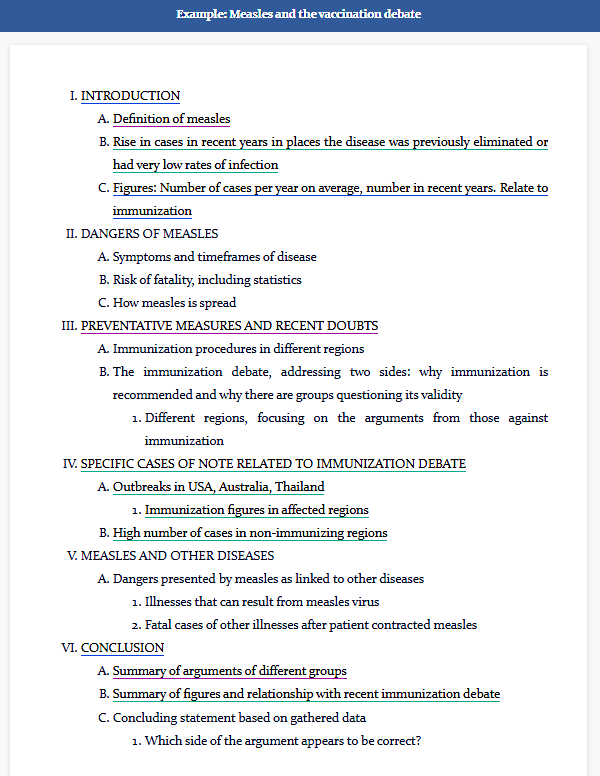
نحوه نوشتن Essay
حتماً برای شما هم این سوال مطرح شده است که چگونه Essay بنویسیم و برای این کار چه مراحلی را باید پشت سر بگذاریم. در این بخش از مطلب، به این سوال به طور کامل و با مثال پاسخ خواهیم داد. قبل از هر چیز، لازم است اجزای مختلف «essay» را بشناسیم.
برای نوشتن essay باید با اجزای آن آشنا شویم. هر essay از بخشهای زیر تشکیل شده است که در کنار هم متن کاملی را شکل میدهند:
- «مقدمه» (Introduction)
- «جمله محوری» (Thesis statement)
- «بدنه» (Body)
- «کلمات و عبارات ربطدهنده» (Transitions)
- «نتیجهگیری» (Conclusion)
- «ذکر منبع» (Citation)
در جدول زیر میتوانید اجزای مختلف essay را مشاهده کنید. در ادامه نیز درباره هر یک از این بخشها توضیحاتی ارائه خواهیم کرد.
| Introduction |
| Thesis Statement |
| Main idea |
| Main Idea |
| Main idea |
| Conclusion |
مقدمه
مقدمه با معرفی موضوع، مخاطب شما را به سوی مقاله هدایت میکند. به همین دلیل بخش مهمی از «essay» را به خودش اختصاص میدهد. مقدمه باید به گونهای شروع شود که نظر مخاطب را جلب کند و به خواندن کل متن علاقهمند شود. برای مثال، میتواند با نقلقول، مقایسه، پرسش یا مواردی از این قبیل شروع شود. پس از آنکه خواننده جذب مقدمه شد، لازم است در همان بخش، اطلاعاتی را درباره موضوع منتقل کنیم که به درک بهتر متن به خواننده کمک میکند. ایدههایی که در مقدمه مطرح میشوند، باید کلی باشد تا خواننده در ابتدای متن درگیر جزئیات نشود و درک کلی از موضوع پیدا کند و درواقع بداند که قرار است در ادامه «essay» با چه چیزی روبهرو شود. بنابراین، برای نوشتن «wssay»، مقدمه را با کلیاتی شروع میکنیم و در ادامه کمکم مخاطب را به سمت جزئیات سوق میدهیم.
جمله محوری
جمله محوری باید به طور دقیق ایده اصلی یا موضوع بحث «essay» را مشخص کند، محدودیتهای مربوط به موضوع را شرح دهد و ساختاربندی «essay» را نشان دهد. جمله محوری دقیقاً مانند نقشهای برای کل «essay» عمل میکند و به خواننده میگوید که قرار است چه چیزی را تا انتهای متن بخواند و نویسنده از چه جملاتی برای دفاع از جمله محوری استفاده خواهد کرد.
بدنه
بدنه «essay» از جمله اصلی دفاع میکند. هر ایده توسط یک یا چند پاراگراف بسط داده میشود و با جزئیات ویژهای مورد حمایت قرار میگیرد. این جزئیات شامل دفاع از جملات اصلی با ذکر پژوهشها و تجارب مختلف است که با توجه به نوع موضوع مطرح میشود. علاوه بر این، تحلیلهای خود نویسنده و بحث درباره موضوع باعث ایجاد ارتباط میان ایدهها میشود و به نتایجی دست پیدا میکند که بیانگر حمایت بیشتر از جمله محوری است. برای اینکه بتوانید از جمله محوری بیشتر دفاع کنید، میتوانید مثالهایی را برای دفاع از جمله اصلی و جملات پشتیبان ارائه دهید که برگرفته از تجارب شخصی شما یا بر اساس دادههای آماری است که از صحت آنها تقریباً اطمینان دارید. با این کار خواننده را به ادامه ماجرا ترغیب میکنید.
کلمات و عبارات ربطدهنده
کلمات و عبارات ربطدهنده پاراگرافها را به هم و به جمله محوری ربط میدهند. آنها را میتوان در ابتدای جمله یا بین پاراگرافها قرار داد تا خوانده بتواند ادامه متن را از یک موضوع به موضوع دیگر دنبال کند. «Transition word» میتواند یک کلمه باشد یا از دو یا چند کلمه تشکیل شده باشد. همچنین اگر متن «essay» فرایندی را شرح میدهد، ممکن است نیاز داشته باشیم که از کلماتی مانند «First» و «Next» یا «Finally» استفاده کنیم تا روند پروسه را از هم تفکیک کنیم و هر یک را به طور مجزا شرح دهیم. بنابراین، کلمات ربطدهنده وظیفه دارند تا جملات را به یکدیگر و به پاراگرافهای بعدی وصل کنند تا «انسجام» (Coherence) بین اجزای مختلف جمله برقرار شود. جمله محوری در هر پاراگراف نیز اغلب به عنوان رابط عمل میکند.
نتیجهگیری
نتیجهگیری میتواند ایدههای اصلی یک «essay» را به هم وصل کند. همچنین میتواند به جمله محوری اشاره داشته باشد و ذهن خواننده را معطوف یک جمعبندی کلی بکند و حس آرامشی در او ایجاد کند از اینکه متن را خوانده و به یک نتیجهگیری کاملی دست یافته است. در نتیجهگیری، موضوعات جدید یا ایدههایی که در مقاله به اندازه کافی شرح داده نشده یا به آنها اشارهای نشده است، نباید معرفی شوند. فقط لازم است خلاصهای از کل متن در حد دو سه جمله و در قالب یک پاراگراف کوچک داده شود تا خواننده بتواند در ذهنش یک جمعبندی کلی از «essay» بکند.
البته روش دیگری غیر از خلاصهنویسی برای نوشتن پاراگراف نتیجهگیری وجود دارد. در این روش، نویسنده میتواند «پارافریز» (Paraphrase) جمله اصلی یا همان موضوع محوری را که در مقدمه به آن اشاره کرده، به روی کاغذ بیاورد. پارافریز کردن به معنی نوشتن دوباره یک عبارت، جمله یا پاراگراف است به گونهای که همان معنی را منتقل کند اما با کلمات دیگری بیان شود. یعنی معنی تغییری نکند، اما ظاهر جمله طوری تغییر کند که هیچ شباهتی به جمله اصلی نداشته باشد. استفاده از کلمات مترادف یا متضاد در چنین شرایطی میتواند به پارافریز کمک کند.
ذکر منبع
ذکر منبع یا سایتیشن در مواقعی ضرورت پیدا میکند که مقاله پژوهشی باشد. باید اطمینان حاصل کنید که هر یک از منابعی که ذکر میشود، کاملاً معتبر باشد و از صفحات «Works Cited/References/Bibliography» انتخاب شده باشد.
نوشتن پاراگراف انگلیسی
برای اینکه بدانیم چگونه Essay بنویسیم و نحوه نوشتن پاراگراف را یاد بگیریم، باید ابتدا بدنیم که پاراگراف چیست و از چه اجزایی تشکیل شده است. به همین دلیل، ابتدا پاراگراف را تعریف میکنیم و سپس اجزای مختلف آن را بررسی خواهیم کرد تا به کمک آن بتوانیم به نحوه نوشتن پاراگراف انگلیسی بپردازیم.
یک پاراگراف باید موضوع یا ایده اصلی داشته باشد. پاراگراف را به سه دسته تقسیم میکنند که عبارت است از:
- «جمله اصلی یا محوری» (Topic Sentence)
- «جمله پشتیبان» (Supporting Idea)
- «جمله نتیجهگیری» (Concluding Sentence)
جمله اصلی یا محوری معمولاً به اولین جمله پاراگراف گفته میشود که اطلاعاتی را به خواننده منتقل میکند. این اطلاعات به او نشان میدهد که قرار است در ادامه چه چیزی را بخواند و با چه مواردی آشنا شود. به همین دلیل نوشتن یک جمله محوری خوب، تأثیر زیادی بر متقاعد کردن خواننده برای خواندن متن و ترغیب او به دنبال کردن موضوع است. برای اینکه بتوانید با اجزای مختلف یک پاراگراف آشنا شوید، نمونه از آن را در ادامه آوردهایم و سه بخش آن را مجزا کردهایم.
متن زیر به موضوع «?Does social media enhance cross-cultural connection» پرداخته است.
Research indicates that while digital communication has enhanced the capacity of people to connect across cultures, there are limitations regarding how this communication translates to genuine connection. Many scholars suggest that social media is a way for people to form relationships in the digital space even though they may be separated geographically. Smith (2010, p. 75) suggests that technology has “greatly enhanced” the capacity of people to connect through digital platforms such as Facebook, Twitter and Instagram. Rogers et al. (2019) propose that these kinds of technology platforms not only benefit users in terms of social connectivity but also significantly impact the distribution of knowledge between people and cultures. Similarly, in a study of over 1,500 participants in Australia, China, India and Germany, Cosgrove (2018) found that people who regularly used social media were more likely to engage in activities from other cultures. However, other scholars suggest there are significant limitations to the extent to which social media enhances cross-cultural connections. While Harrison (2017, p. 9) agrees that technology has increased the capacity for people to communicate across cultures, he raises concerns that such forms of communication fail to “foster in-depth relationships” between people and communities from different cultures. In a similar way, James (2020) suggests that developments in technology must be accompanied by rigorous and meaningful debate about the possibilities and limitations of such communication in terms of cultural connection. Going further, Markson (2018, p. 18) warns that digital communication platforms, while seeming to enhance connection, actually “erode the fundamental principles of cross-cultural engagement” by reducing important and complex aspects of culture to “instant images … for immediate gratification rather than deep understanding". While social media platforms offer the chance for many people from different cultures to connect, more research needs to be done regarding the quality of such connections.
اکنون هر یک از اجزای این پاراگراف را از هم تفکیک میکنیم و در دستهبندی جداگانه نمایش میدهیم.
Topic sentence: Research indicates that while digital communication has enhanced the capacity of people to connect across cultures, there are limitations regarding how this communication translates to genuine connection.
Supporting sentences: Many scholars suggest that social media is a way for people to form relationships in the digital space even though they may be separated geographically. Smith (2010, p. 75) suggests that technology has “greatly enhanced” the capacity of people to connect through digital platforms such as Facebook, Twitter and Instagram. Rogers et al. (2019) propose that these kinds of technology platforms not only benefit users in terms of social connectivity but also significantly impact the distribution of knowledge between people and cultures.
Body paragraph 1: Similarly, in a study of over 1,500 participants in Australia, China, India and Germany, Cosgrove (2018) found that people who regularly used social media were more likely to engage in activities from other cultures. However, other scholars suggest there are significant limitations to the extent to which social media enhances cross-cultural connections.
Body paragraph 2: While Harrison (2017, p. 9) agrees that technology has increased the capacity for people to communicate across cultures, he raises concerns that such forms of communication fail to “foster in-depth relationships” between people and communities from different cultures. In a similar way, James (2020) suggests that developments in technology must be accompanied by rigorous and meaningful debate about the possibilities and limitations of such communication in terms of cultural connection. Going further, Markson (2018, p. 18) warns that digital communication platforms, while seeming to enhance connection, actually “erode the fundamental principles of cross-cultural engagement” by reducing important and complex aspects of culture to “instant images … for immediate gratification rather than deep understanding".
Concluding sentence: While social media platforms offer the chance for many people from different cultures to connect, more research needs to be done regarding the quality of such connections.
حال میخواهیم به این موضوع بپردازیم که هر یک از این دستهبندیها چه مفهومی دارند و چگونه میتوانند در نوشتن یک پاراگراف بهتر به ما کمک کنند.
- Topic sentence: جمله محوری، ایده اصلی پاراگراف را توضیح میدهد و اطلاعاتی را در اختیار مخاطب قرار میدهید که ایدهای کلی درباره چیزی است که قرار است بخواند. در حالت کلی، جمله محوری در ابتدای پاراگراف قرار میگیرد، اما محل قرار گرفتن آنها ممکن است بر اساس نحوه سازماندهی شخصی و انتظارات مخاطب متفاوت باشد. جملات محوری اغلب به عنوان جملاتی ربطدهنده برای ورود به پاراگراف جدید عمل میکنند.
- Supproting sentences: جملات پشتیبان ایدههای جدیدی را معرفی میکنند و تحقیقات نویسندگان دیگر را برای بررسی ایدههای بیشتری که در جمله محوری معرفی شده است، نشان میدهند. برای نوشتن جزئیات در جملات پشتیبان باید بتوانید ارتباط این جملات را با جمله محوری نشان دهید. این جملات برگرفته از منابع مختلفی هستند که باید حاوی تحلیلهای شخصیِ نویسنده نیز باشند. بنابراین، میتوانیم شاخصهای جملات پشتیبان را به شکل زیر دستهبندی کنیم:
- نظرات تخصصی
- حقایق و آمار و احتمالات
- تجارب شخصی
- تجارب دیگران
- مثالهای مختصر
- مطالعات پژوهشی
- تحلیلهای شخصی نویسنده
- مصاحبهها
- Body paragraph 1: در بخش اول پاراگراف بدنه، نویسنده نظریاتی را دستهبندی کرده است که رسانههای اجتماعی به عنوان نمونهای از روابط بین فرهنگی از آن حمایت کردهاند.
- Body paragraph 2: در بخش دوم پاراگراف بدنه، نظر افراد مخالف را به چالش میکشد و از «عبارتهای ربطدهنده» (Linking Phrases) مانند «similarly» و «however» استفاده میکند تا رابطه منطقی بین ایدهها را نشان دهد.
- Concluding sentence: جمله نتیجهگیری، ایده اصلی پاراگراف را خلاصه میکند و هر یک ارتباط پاراگراف را با بخشهای گستردهتر یا با پاراگراف بعدی به نمایش میکشد.

Unity و Coherence در پاراگراف نویسی چیست؟
برای اینکه به سوال چگونه essay بنویسیم پاسخ دهید، باید دو موضوع مهم را در هر یک از پاراگرافهای آن رعایت کنید. این دو فاکتور مهم «Unity» و «Coherence» است. «Unity» به معنای یکپارچگی و «Coherence» به معنای انسجام است. وقتی صحبت از یکپارچگی میشود، درواقع تمرکز به سمت جمله اصلی یا همان جمله محوری معطوف میشود. البته جملات پشتیبان نیز باید از جمله اصلی حمایت کنند و درباره آن توضیحاتی را ارائه کنند. در غیر این صورت، «essay» فاقد هر گونه یکپارچگی خواهد بود. بنابراین، «Paragraph unity» به این معنی است که بین جمله محوری، جملات پشتیبان، مثالهایی که برای توصیف جزئیات بیشتر مطرح میشود و در نهایت جمله نتیجهگیری، از نظر معنی و توالی، یکپارچگی وجود دارد. این مورد باعث میشود که خواننده کشش بیشتری به دنبال کردن متن داشته باشد و ساختاری دستهبندیشده در ذهنش شکل بگیرد.
انسجام پاراگرافها نیز اهمیت زیادی دارد و به معنی برقراری ارتباط بین ایدههای ارائهشده در یک پاراگراف است. با رعایت کردن این موضوع میتوانیم به ایدههای خود نظم و ترتیب بدهیم و ارتباطی منطقی میان جملهها و پاراگرافها ایجاد کنیم. در ادامه میتوانید نمونهای از یک پاراگراف را در essay مشاهده کنید که موارد «Unity» و «Coherence» مورد بررسی قرار گرفته شدهاند.
در این بخش از مطلب چگونه essay بنویسیم دو پاراگراف را به عنوان نمونه مشاهده میکنید. پاراگراف اول «Coherence» و «Unity» ندارد، درحالیکه در پاراگراف دوم شاهد هر دوی این ویژگیها هستید. سعی کنید هر دو پاراگراف را باهم مقایسه کنید.
Incoherent Paragraph:
The sun was shining brightly in the sky. I went to the store to buy some groceries. My dog likes to play in the park. There is a new movie in theaters. The traffic was terrible on my way home. I enjoy reading books. The beach is a great place for a vacation.
Revised Coherent Paragraph:
On a sunny day, I decided to head to the store to buy groceries. While walking in the park, I noticed that my dog loves to play and run around. I also learned that there's a new movie playing in theaters that I might want to watch. However, the traffic on my way home was terrible, making the journey more challenging. Despite the traffic, I find solace in enjoying my time reading books. Dreaming of a relaxing vacation, the beach always comes to mind as a perfect destination.
نکات مهم در ساختاربندی و نوشتن پاراگرافهای بهتر
فرقی نمیکند که پاراگراف کوتاهی بنویسید یا بلند؛ هر پاراگرافی باید اساسیترین قوانین مربوط به ساختاربندی را رعایت کند. البته این قوانین در رابطه با نوشتن داستانهای واقعی یا تخیلی چندان صدق نمیکند، اما اطلاعاتی که در داستان خود نقل میکنید، باید به شکلی منطقی به پاراگراف بعدی مرتبط باشد. اگر این توالی را رعایت نکنیم، خواننده نمیتواند درکی از داستان داشته باشد و حتی ممکن است به دلیل عدم انسجام در توصیف روایتهای داستانی و شخصیتها، به مرحلهای برسد که آن را رها کند. بنابراین، ایجاد انسجام و نظم در پاراگرافها میتواند تأثیر زیادی در بهبود پاراگرافنویسی داشته باشد. در ادامه این مطلب از «مجله فرادرس» به نکات مهمی در خصوص نحوه نوشتن پاراگرافهای بهتر و ساختاربندی آنها میپردازیم.
- اولین جمله پاراگراف خود با «جمله اصلی» (Topic Sentence) شروع کنید. اولین خط از هر پاراگراف به خواننده اطلاعاتی میدهد تا بداند قرار است با چه مواردی مواجه شود. حتی اگر «essay» از نوع داستانی باشد، مقدمه پاراگراف ایده یا سناریوی اصلی را شکل میدهد. صرفنظر از اینکه چه ساختار یا فرمتی را قرار است رعایت کنیم، هر پاراگراف خوب باید با یک جمله محوری شروع شود و بقیه اجزای پاراگراف بر اساس آن شکل بگیرد.
- از «جملات پشتیبان» (Supporting Ideas) برای حمایت از ایده محوری استفاده کنید. در این جملات، میتوانید به مواردی اشاره کنید که در جمله محوری مدنظر قرار داده بودید. در واقع میتوانید به کمک این جملات خواننده را متقاعد کنید که نوشته شما را بخواند و دیدگاه جامعی درباره موضوع در اختیار او قرار دهید.
- در صورت نیاز، از مثالهایی برای بیان جزئیات بیشتر درباره جملات پشتیبان استفاده کنید. مثال زدن باعث میشود که خواننده اطلاعاتی را که به عنوان جمله محوری و جمله پشتیبان مطرح شده است، بهتر درک کند. بدین ترتیب بیشتر ترغیب خواهد شد که داستان را ادامه دهد.
- جملهای به عنوان جمله نتیجهگیری بنویسید. برای نوشتن هر پاراگراف، لازم است که آن را به گونهای به پایان برسانید. میتوانید از یک جمله به عنوان نتیجهگیری استفاده کنید و پاراگراف را به نوعی جمعبندی کنید. در نظر داشته باشید که این جمعبندی، میتواند خلاصه آن چیزی باشد که در پاراگراف شرح دادهاید. درواقع، هدف از نوشتن جمله نتیجهگیری این است که پاراگراف را نیمهکاره رها نکنیم و تصویری کلی در ذهن مخاطب شکل بگیرد.
- بدانید که چه زمانی باید پاراگراف جدید را شروع کنید. برای اینکه پاراگراف جدیدی را شروع کنید، باید بدانید که کجا پاراگراف قبلی را بشکنید و پاراگراف جدیدی را شروع کنید. برای مثال، در نوشتن رمان، ممکن است هنگام ورود شخصیت جدیدی به داستان، پاراگراف جدیدی را شروع کنید. همچنین زمانی که قرار است شخصیت متفاوتی صحبت کند، لازم است مکالمه یا مونولوگ را در پاراگراف جداگانهای بنویسیم تا خواننده بتواند متن توصیفی را از مکالمه تفکیک کند. برای سایر موارد، هنگامی که پاراگراف توضیحات زیادی دارد یا نیاز است که جملهای را به شکلی مجزا مطرح کنیم، پاراگراف را به دو قسمت یا بیشتر تقسیم میکنیم.
اهمیت علائم نگارشی در Essay
برای نوشتن essay به زبان انگلیسی، باید این نکته مهم را در نظر داشته باشیم که خواننده قرار است صرفاً با متنی نوشتاری مواجه شود که برخلاف حالت گفتاری، هیچ احساسی را نمیتواند به مخاطب خود منتقل کند. اما از آنجا که essay انواع مختلفی دارد و در ابتدای مطلب به آن اشاره کردیم، برای نوشتن آن باید خواننده را به گونهای جذب کنیم که به خواندن متن ترغیب شود و تا پایان متن آن را پیش ببرد. برای این منظور میتوانیم از قوانین نشانهگذاری در زبان انگلیسی کمک بگیریم. این علائم در زبان انگلیسی اهمیت بسیار زیادی دارند، زیرا به کمک آنها خواننده میتواند متن را بهتر درک کند و با گذاشتن علائمی مانند علامت تعجب یا علامت سوال، لحن بیان نویسنده نیز به او منتقل شود. بنابراین یکی از مواردی که هر نویسنده یا ویراستاری باید با آن آشنایی کافی داشته باشد، علامتهای نشانهگذاری است که در نوشتههای آکادمیک ضرورت بیشتری پیدا میکند.
در بسیاری از رمانها و مقالات علمی، رعایت علائم نشانهگذاری میتواند تأثیر بسیار زیادی در بالا بردن سطح نوشته شما داشته باشد. حتی میتواند مخاطب را بیشتر جذب کند، زیرا بهتر میتواند با قلم و لحن نوشتاری نویسنده ارتباط برقرار کند. این امر در نوشتن مقالههای آکادمیک و پایاننامه اهمیت بیشتری پیدا میکند، زیرا این نوع نوشتهها باید دقیق باشند. در رایتینگ آکادمیک، نویسنده ممکن است هنگام استفاده از جملات پیچیدهتر دچار سردرگمی شود و در این میان، استفاده درست از علائم نشانهگذاری میتواند این مشکل را حل کند و نویسنده و همینطور مخاطب را با چالشهای زیادی مواجه نکند.
در ادامه این مطلب، به بررسی و نقش علائم نشانهگذاری در essay میپردازیم. اما قبل از هر چیز ابتدا باید بدانیم که اهمیت علائم نشانهگذاری در زبان انگلیسی چیست. به طور کلی، چهار دلیل برای استفاده از علائم نشانهگذاری در زبان انگلیسی وجود دارد که عبارتند از:
- علائم نشانهگذاری به مخاطب این امکان را میدهد که پیام درستی از متن دریافت کند و جملات آن را به درستی درک کند.
- در رایتینگ آکادمیک، علامتهای نشانهگذاری میتوانند دلایل ارائهشده را با قاطعیت بیشتری به خواننده منتقل کنند و استدلالهای نویسنده و نظراتش را با صراحت بیشتری به گوش مخاطب برسانند.
- عدم استفاده از علامتهای نشانهگذاری یا استفاده نادرست از آنها میتواند مفهوم و معنی جمله را بهکل تغییر دهد و حتی ممکن است خواننده برداشت اشتباهی بکند.
- علامتهای نشانهگذاری بر روی «مکثها» (Pauses)، افکار، ایدهها و حتی بر روی لحن و احساسات نویسنده که روی کاغذ آمده تأثیر میگذارد.
انواع علائم نشانهگذاری در Essay
اکنون که با کاربرد و ضرورت استفاده از علائم نشانهگذاری آشنا شدیم و دریافتیم که برای اینکه بدانیم چگونه essay بنویسم و برای نوشتن آن از علامتهای نشانهگذاری درست و مناسب استفاده کنیم، در ادامه این مطلب از «مجله فرادرس» به بررسی انواع علامتهای نشانهگذاری میپردازیم. در دستهبندی زیر میتوانید این علائم را مرور کنید.
- «نقطه» (Periods)
- «ویرگول» (Commas)
- «نقطهویرگول» (Semicolons)
- «علامت تعجب» (Exclamation marks)
- «علامت سوال» (Question marks)
- «دونقطه» (Colons)
- «آپاستروف» (Apostrophes)
در ادامه هر یک را به طور جداگانه و با مثال توضیح میدهیم.
- نقطه (Period): به شکل «.» نوشته میشود و یکی از علائم نشانهگذاری بسیار پرکاربرد است که به آن «Full stop» نیز میگویند. همانطور که اسمش نشان میدهد، اغلب در انتهای جمله و به نشانه تمام شدن جمله گذاشته میشود. نقطه را در انتهای جمله خبری (Delarative Sentence) قرار میدهیم. آن را بعد از کلمات مخفف در انگلیسی (Abbreviation) نیز میبینیم. به مثالهای زیر دقت کنید تا با کاربرد این علامت نشانهگذاری در زبان انگلیسی بیشتر آشنا شوید. در مثال اول، نقطه را در پایان جمله خبری و در مثال دوم بعد از کلمات مخفف میبینید.
I worked from morning to evening.
من از صبح تا عصر کار کردم.
He is Dr. Jonathan of the ER dept.
او دکتر جاناتان از دپارتمان ER است.
- «ویرگول» (Commas): به شکل «,» نوشته میشود و در زبان انگلیسی کاربردهای زیادی دارد. ویرگول انگلیسی یا کاما نشاندهنده مکثی کوتاه در هر جایی از جمله است تا مفهوم جمله را به شکل آشکارتری منتقل کند. ویرگول برای اهداف مختلفی در جمله قرار میگیرد، مانند دستهبندی کردن آیتمها، جدا کردن عبارتها و مواردی از این قبیل. اما استفاده نادرست از آن میتواند خواننده را در درک موضوع سردرگم کند. به مثال زیر دقت کنید.
Correct: We will learn how to cut and paste, children!
درست: بچهها، ما یاد میگیریم چطور کات و پیست کنیم.
***
Incorrect: I was ready to leave, but it started raining, so I called a taxi, but it was late, so I was late.
نادرست: من آماده رفتن بودم، اما باران شروع شد، به همین دلیل تاکسی گرفتم، اما دیروقت بود، برای همین دیرم شد.
(در این مثال هیچ نیازی نیست که اینهمه ویرگول بگذاریم.)
به چند مثال دیگر و نحوه استفاده از ویرگول در هر یک از آنها توجه کنید.
In lists: I need to buy coffee, mayonnaise, and eggs from the grocery store.
برای دستهبندی آیتمها: من باید قهوه، مایونز و تخممرغ از خواربارفروشی بخرم.
Direct speeches: He exclaimed, “Watch out!”
در نقلقول مستقیم: او با تعجب فریاد زد: «مراقب باش!»
(در ترجمه فارسی از ویرگول استفاده نمیکنیم.)
Incorrect: I love my parents, My sister and my friends.
Correct: I love my parents, My sister, and my friends.
درست: من عاشق خانوادهام، خواهرم و دوستانم هستم.
به چند مثال دیگر توجه کنید.
We need to choose between samples A, B, or C.
ما باید بین نمونههای B, A یا C یکی از انتخاب کنیم.
The survey depended on the age, gender, and location of the participants.
همهپرسی به سن، جنس و محل سکونت شرکتکنندهها بستگی داشت.
- «نقطهویرگول» (Semicolons): یکی از علامتهای نشانهگذاری در زبان انگلیسی که معمولاً آن را با ویرگول اشتباه میگیرند، نقطهویرگول است که به صورت «;» نوشته میشود. همانطور که در رابطه با ویرگول مطرح شد، کامل آیتمها را در یک فهرست از هم جدا میکند، اما برای تفکیک دو «جملهواره مستقل» (Independent Clause) از نقطهویرگول استفاده میکنیم، مانند مثال زیر:
Incorrect: Smith had never ridden on the back of a camel, he tried out of curiosity.
Correct: Smith had never ridden on the back of a camel; he tried out of curiosity.
درست: «اسمیت» هیچوقت شترسواری نکرده بود؛ از سر کنجکاوی آن را امتحان کرد.
اگر بخواهیم از ویرگول استفاده کنیم، باید یکی از جملهوارهها وابسته باشد، بنابراین با تغییر مثال فوق به شکل زیر میتوانیم ویرگول را بین دو جمله قرار دهیم:
Correct: Smith had never ridden on the back of a camel, so he tried out of curiosity.
درست: «اسمیت» هیچوقت شترسواری نکرده بود، برای همین از سر کنجکاوی آن را امتحان کرد.
- «علامت تعجب» (Exaclamation marks): از علامت تعجب در انتهای جمله استفاده میشود که یا تعجب یا شوکه شدن از چیزی را نشان میدهد و در نقلقول مستقیم به کار میرود. در این نوع جملات معمولاً گوینده از چیزی تعجب کرده است به همین دلیل با صدای بلند صحبت میکند یا فریاد میزند. همچنین در مواقعی که نویسنده مورد جالبی را تشخیص میدهد، از این علامت استفاده میکنیم که به شکل «!» در انتهای جمله میآید. در ادامه میتوانید به چند مثال توجه کنید که در انتهای آنها علامت تعجب آمده است.
Denoting surprise or exclamation: Hi! How can I help you?
برای نشان دادن تعجب: سلام! چطور میتوانم کمکت کنم؟
Denoting a shout or scream: The guard shouted, “Watch out!”
برای فریاد زدن یا جیغ زدن: نگهبان فریاد زد: «مراقب باش.»
Denoting amusement: To think they would not recognize me!
برای بیان هیجان: فکرش را بکن آنها من را نشناسند!

- «علامت سوال» (Question marks): علامت سوال که به شکل «?» در انتهای جمله میآید، اغلب در مواقعی به کار میرود که سوالی به شکل مستقیم مطرح میشود، مانند جمله پرسشی زیر:
When will you return home?
کی به خانه برمیگردی؟
- دونقطه (Colons): از دونقطه «:» بعد از یک کلمه استفاده میشود که برای توضیح دادن، ارائه مثال و افزودن عبارت دیگر به کار میرود که عبارت قبلی را توصیف میکند، مانند دو مثال زیر:
There were three variants: green, blue, and red.
سه نوع مختلف وجود داشت: سبز، آبی و قرمز.
We did not go to the fair: we were already late.
ما به جشنواره نرفتیم: خیلی دیرمان شده بود.
Incorrect: He bought the following food items; burger and coke.
Correct: He bought the following food items: burger and coke.
درست: او این آیتمهای غذایی را خرید: برگر و نوشابه.
- «آپاستروف» (Apostrophes): آپاستروف به شکل «'» نوشته میشود و دو کاربرد مهم دارد: برای نشان دادن حروفی که نمینویسیم و درعوض شکل کوتاه آنها را با آپاستروف نشان میدهیم. به این کار «Contraction» گفته میشود. و برای نشان دادن مالکیت در انگلیسی به کار میرود. به مثالهای زیر توجه کنید.
I am → I'm
You will → You'll
They would → They'd
و برای نشان دادن مالکیت، مثالهای زیر نمونههای خوبی هستند.
The girl's hat - means that the hat is owned by the girl.
کلاه دختر - یعنی کلاهی که متعلق به دختر است.
The girl's hats - means that the girl owns more than one hat.
کلاههای دختر - یعنی دختری که بیش از یک کلاه دارد.
The girls' hat - means that the girls all share ownership of one hat.
کلاه دختران - یعنی دخترهایی که یک کلاه را با هم به صورت مشترک استفاده میکنند.
The girls' hats - means that the girls own several hats (or one each).
کلاههای دخترها - یعنی دخترانی که چند کلاه دارند ( یا هر کدام صاحب یک کلاه هستند).
نکته: برای نوشتن essay از «contraction» یا همان شکل کوتاه کلمات استفاده نمیکنیم، زیرا حالت کاملاً غیررسمی پیدا میکند. بنابراین در نوشتار انگلیسی و در رایتینگ آکادمیک از شکل کامل کمک میگیریم.
از دیگر کاربردهای آپاستروف در زبان انگلیسی برای نشان دادن تاریخ است. به مثالهای زیر و توضیحات آنها توجه کنید.
The 1960s were a period of radical changes in morality.
دهه نود (۱۹۶۹ - ۱۹۶۰)، دوره تغییرات افراطی در اصول اخلاقی بود.
(«s» در این مثال یک دهه را از سال ۱۹۶۰ تا ۱۹۶۹ نشان میدهد و آپاستروف نیست.)
In the '60s, public morality underwent radical changes.
دهه نود (۱۹۶۹ - ۱۹۶۰)، شعور اجتماعی دستخوش تغییرات افراطی شد.
(در این مثال، «19» را قبل از «60» نیاوردهایم و بهجای آن آپاستروف استفاده شده است.)
1960s' morality was quite different to that which had gone before.
اصول اخلاقیِ دهه نود، در مقایسه با قبل کاملاً متفاوت بود.
(در این مثال، به اخلاقیات دهه نود اشاره شده است که مالکیت را نشان میدهد.)
موضوع برای نوشتن Essay
برای اینکه بدانیم چگونه essay بنوسیم لازم است درباره موضوعات آن بدانیم. برخی از موضوعات پیشنهادی برای نوشتن Essay در دسته موضوعات پرتکرار قرار میگیرد. یعنی در آزمونهای مختلف ممکن است بارها شاهد موضوعاتی باشیم که چندین بار تکرار شده است یا مشابه آنها را دیدهایم. با در نظر گرفتن این موضوع میتوانیم برای نوشتن Essay آمادگی بیشتری داشته باشیم و روی این موضوعات کار کنیم و با آموختن لغات انگلیسی و عبارات مناسب برای این عنوانها، اعتمادبهنفس بیشتری برای نوشتن متن خود پیدا کنیم و در مجموع Essay بهتری بنویسیم. در این بخش از مطلب «چگونه Essay بنویسیم»، قصد داریم به برخی از این موضوعات رایج اشاره کنیم و نمونهای را برای هر یک معرفی کنیم.
موضوع اول: Protecting the Natural Environment Essay
یکی از موضوعات پرتکرار برای Essay به محیط زیست مربوط میشود. در ادامه متنی را مشاهده میکنید که در پاسخ به موضوع فوق نوشته شده است. تعداد کلمات این متن ۱۲۳۲ و سطح آن متوسط است.
نمونه Essay
Whether we should think about the future of the environment as a matter of doing justice to future generations, is based upon the grounds to which we should be obliged to work to protect the environment. The protection of the environment is a basic human duty and a natural law to which we all depend upon to live from day to day. It is a duty by individuals, organizations and governments to incorporate policy approaches to fulfill this. As part of the Intergenerational Justice concept, the extents and limits of Social Justice regarding the need to protect the natural environment, justify the basis to which we owe duties, to us and the future generations to follow.
This essay will discuss whether we should be obliged to work today to protect the environment, for the needs and interests of future generations. On the other hand, whether it comes down to the basic deep ecological view that nature is intrinsically valuable. Furthermore, considerations will be addressed on protecting the environment as a matter of Justice to future generations, and if so, on what grounds.
The global nature of threats to the environment and the necessity of international cooperation were first recognized in the UN's Conference on the Human Environment held in Stockholm in 1972. The Stockholm Declaration issued by the conference recognized the right to a healthy environment, on the part of both present and future generations, and called for countries to preserve nonrenewable resources and to prevent damage to ecosystems and to the earth's atmosphere. Environmental intergenerational duties and natural law are two theories used to weigh up the extent to which we have a duty to protect the natural environment. The extents and limits of social justice in the intergenerational concept justify the basis of how and why we owe our duties.
Northcott argues the location of the origins of the current environmental crisis in the rise of modernist science and economics, and emphasises that a solution to the issues lies in the Christian tradition of Natural Law ethics. Northcott also emphasizes the non-religious, natural law abiding reasoning for the basis of protecting the natural environment, through social and anthropological arguments - as well as evaluating Natural Law precepts are found under all religious denominations in the Modern Society. Whether this gives grounds for protecting the environment is up to debate. There is an emphasis that Natural Law and intergenerational duties cover all humans. Thus, we all have the duty to protect and not just exploit with disregard for future generations.
A just account of the environment will take into consideration both the fact that people have legitimate interests, and there must be limits on people's environmental impacts. The Egalitarian concept presses the position of equality of opportunity requires us to protect the natural environment, through our ability to live a good life should not be undermined by unchosen circumstances - factors beyond our control. Such factors would be that of future generations who have to live a limited life due to a damaged environment. People both in the present and the future must have sufficient resources so that there is equal opportunity to live a good life.
Protecting the environment for future generations must incorporate whole society movements and changes to everyday life to ensure that the natural environment is protected from today, so forth for future generations. Since the 1980s, the concept of sustainability has been adopted to describe a compromise between the need for economic development and the protection of resources for future generations. Schumacher takes the principle challenge through the Buddhist economic approach on the principle of âright livelihoodâ. This illustrates the types of radical changes and challenges to individual economies, which cannot be sustained by the poor nations. Further to this the challenges in protecting the natural environment as a matter of justice. Industrial development is the temporary cushion and developments which can offer medium-term benefits to poor countries, and coordinated through international action; though proves difficult under such circumstances. Bridging the gap between global coordinationcommunication and individuals lifestyle choices, could have the ability to create the grounds for the radical change necessary at this point.
Deep Ecology has shaped the understanding of Arne Naess and Val Plumwood, forming the foundational argument on the basis of why the natural environment has to be protected for future generations. That nature does not need protection, but requires protection. From the deep ecology perspective, the natural world must be preserved due to its inherent value and humans should only affect it to protect vital needs. In this argument humans should not seek to protect the environment, rather that nature is intrinsically valuable. In Reasons and Person (1984) Derek Parfit illustrates the problem with an influential basic observation, Future persons cannot be rendered worse off by our unsustainable living. Rather, the particular people who will exist in the future will do so as a result of how we decide to live our lives. John Rawls goes further to suggest environmental degradation threatens political stability and access to goods upon which many rights depend. However, as Richard Hiskes argues, the modern dilemma inquiries humans to look after the environment as a matter of moral obligation, rather than an actual requirement of Justice.
Through the concept of Human Rights another approach is addressed. As a key moral value, endorsed by adherents to a wide variety of different philosophical perspectives. Through a human rights perspective the environment matters, at least in part, because environmental degradation undermines core human rights to food and water, to health, and to life. The Libertarian case brings an unusual approach. Libertarian theorists are in favour of robust private property rights, and individuals should not be expected to transfer their property or spend their income or resources for their protection. As Liebell explains, environmental degradation is a problem for liberalism, but through John Locke's work linked the values of freedom, fairness, and equality to the natural world. A libertarian would think that there is no injustice if the harms wholly arose from natural phenomena, and were not caused by humans. At this present time, climate change, biodiversity loss, or acid rain, are key examples of the environmental impact of human behaviour. Thus, it is justified for a liberalitarian to intercept individual freedoms.
Boulding argues that Humans have traditionally acted as though they live in a Cowboy Economy - an economy with unlimited opportunities - suggesting that this type of Human behaviour towards, what essentially is the environment, has encouraged exploitative, and violent behaviour. In support of this, the Utilitarian principle argues that we should always choose the course of actions that will maximise the amount of happiness or well-being in the world. The Utilitarian case questions why the well-being of future generations should be considered in our calculation to those who live now, and through accepting this premise, then there is clearly an obligation to protect and save natural resources for the future.
To conclude, the natural environment should be protected for future generations based on a moral duty, and a matter of intergenerational justice. The intrinsic value of nature for human life, should be preserved through the equality of opportunity for future generations to have the same opportunities as those today. Further to this, the liberal view demonstrates that what is left (through property means) should be enough and as good for others. Therefore, protecting the natural environment, not only benefits the individual but future generations that will follow.

موضوع دوم: Argumentative Essay About Education
یکی از انواع Essay که در این مطلب به آن اشاره شد، «Argumentative Essay» است و یکی از موضوعات پرتکرار برای نوشتن، به آموزش و تحصیلات مربوط میشود. برای اینکه بتوانیم برای نوشتن این نوع Essay آمادگی داشته باشیم، لازم است در رابطه با موضوعاتی که به آموزش و تحصیل مربوط میشوند، مطالعه کافی داشته باشیم. متن زیر ۱۴۷۳ کلمه است و در پاسخ به همین موضوع نوشته شده است. سطح آن هم متوسط در نظر گرفته شده است. هر یک از پاراگرافهای آن را به شکل زیر دستهبندی کردهایم:
- Introduction to Digital Education and the Pandemic's Impact
- Engaging Young Generations: The Power of Digital Learning
- Preparing for the Future: Integration into the Digital Economy
- Environmental Sustainability and Digital Education
- Cybersecurity Concerns in Online Learning
- Conclusion: Embracing the Disruptive Potential of Digital Education
نمونه Essay
Will the world be the same after the coronavirus pandemic? Most people would probably answer: “No,” especially parents who have been wondering how to keep their kids engaged during the lockdown, teachers who have been struggling to adapt to online teaching, and government officials who have been trying to come up with adequate solutions. The pandemic has revealed the inconsistency of the current educational practices and sheds light on the need for a new educational model. Had education institutions embraced digital learning earlier, they would undoubtedly have shown greater agility in dealing with this unprecedented crisis. Digital education refers to the use of electronic devices and digital media to implement distance online learning or blended learning programs. Digital education enhances our ability to meet the challenges of the future because it has a higher potential to meet young generations’ needs, better integration into the digital economy, and greater environmental sustainability.
First, digital education has proven to create a conducive learning environment, where learners can feel comfortable, empowered, and emotionally engaged. Young students are very comfortable with the use of technology. They love surfing the internet, chatting online, posting on social media, and playing video games; some have virtual friends. They often question the usefulness of spending several hours in the classroom listening to a teacher whose teaching methodology is incompatible with their mindset. To engage them in the learning process, we need to use educational tools adapted to their lifestyle and interests and make learning fun. Videogames are considered by many educators as an excellent learning tool. According to English psychologist Mark Griffiths, video games have a high educational potential when they “are designed to address a specific problem or to teach a certain skill [ ].” Plenty of examples illustrate this claim: Mathmateer is great for learning math, HoloLAB Champions teaches chemistry, “StarCraft” helps develop problem-solving skills, and with CodeCombat you learn programming. Virtual reality and augmented reality tools are used to increase video games' attractiveness and design fully immersive lessons. Thanks to applications such as Unimersiv and Google Expeditions, students can find themselves strolling in the street of ancient Rome; exploring Antarctica’s landscape, and walking on the surface of the moon. In addition to its attractiveness, digital education permits greater learning flexibility. You can learn anywhere, at any time, at your own path and pace. Contrary to the conventional education system that addresses the needs of a whole class, digital learning is more personalized. Integrating technologies into educational systems will make education more suitable for today's students. Interactive and adaptive software can be adjusted to students’ interests and learning styles. By giving learners the opportunity to pursue their topics of interest, prioritize their tasks, and personalize their projects, digital education fosters their autonomy and sharpens their judgment. They can now feel empowered; they aren’t anymore the passive receivers of the knowledge provided by the teacher, but rather the main actors of their own learning. In short, digital education is a powerful engine for learning that drives learners’ motivation, unlocks their potential, and opens their horizons.
Second, the digitalization of education can also accelerate the integration of educational practices into the digital economy and prepare society for the rapidly changing 21st-century employment market. The jobs of the future are those generated by the digital economy. This emerging economy values task-oriented skills and requires greater job mobility. Artificial intelligence, automation, and digitalization are increasingly disrupting the world of work; and it’s becoming clear that tomorrow’s jobs will be radically different from today’s jobs. A report published by the American management consulting company McKinsey in January 2017 estimates that half of today’s work activities could be automated by the mid-21st century[ ]. Manufacturing and administrative jobs will probably undergo a significant decline. But, if the digital economy destroys jobs, it also creates new ones. According to the World Economic Forum, “65% of children entering primary school today will ultimately end up working in completely new job types that don’t yet exist[ ].” Indeed, ICT jobs will continue to be in high demand. Most of the high-paying jobs will evolve from expanding new technologies such as artificial intelligence (AI), the Internet of Things (IoT), cloud blockchain, data analytics, and cybersecurity. In the new knowledge-driven economy, data has become the new source of wealth. Even low-skilled jobs will require a certain level of digital literacy. Hopefully, digital education enables learners to use a range of technology tools to find and assess information, collaborate with others, and produce and share content. Online Project-Based Learning (PLB) helps students develop their communication, interpersonal, problem-solving, and entrepreneurial skills by making learning collaborative and interactive. In the global transformation age, these soft skills' importance can’t be overstated. It’s also essential to provide workers with adequate tools to be reskilled every time they need to switch occupations. Gone are the days when one can dream of a long-life job. To ensure prosperity and maintain social and economic stability, nations should implement an agile and flexible internet-based education system that prepares citizens to learn new skills, not only when they are young, but also at all stages of their working lives. To sum up, tech-driven education helps students develop, not only the skills but also the resilience needed to meet the challenges of a world of constant uncertainty.
Environmental sustainability is an additional argument in favor of the digitalization of education. Many people think that online learning has a positive impact on the environment. If you join a virtual school, you won’t have to use any means of transport (car, bus, train) to go to a physical location every day. You, therefore, reduce your carbon footprint and contribute to the fight against global warming [ ]. Virtual schools also eliminate the need to erect new buildings and consume additional materials and energy or reduce green spaces. Replacing textbooks with e-books saves millions of trees every year and reduces the amount of carbon dioxide, carbon monoxide, and the highly toxic wastewater produced by paper mills. According to the SMARTer2030 report delivered by the Global e-Sustainability Initiative (GeSI), “ICT has the potential to enable a 20% reduction of global CO2 emissions by 2030.”[ ]. In brief, digital technology aims at enhancing energy efficiency and reducing carbon footprint. We can therefore claim that digital education is more environmentally friendly than the traditional education system.
However, online learning prompts security and privacy risks as with all internet-related activities. Identity theft, email harassment, cyber-stalking, indecent exposure, and phishing are the most common crimes that target online learners. Some social media and webinar tools are not privacy-protective by default and can therefore become invasive, undermining an individual's or household's privacy. Even in technically advanced countries, online learning platforms are not shielded against vicious cyberattacks. On April 10th, 2020, the Associated Press reported that Singapore suspended the use of the popular conferencing application Zoom after two hackers had used “Zoom-bombing” to interrupt a lesson and show obscene images to students. According to the same news agency, similar attacks targeted teleconferences and online classes in the US [ ]. While the seriousness of this threat cannot be ignored, there is clear evidence that these security and privacy concerns can be addressed if students, parents, and educators adopt some basic “cyber hygiene” habits.
Elementary school children should learn how to create strong passwords, and develop privacy awareness. Parents should use parental controls and monitor their children’s accounts to avoid any internet misuse. Teenage learners should learn how to spot phishing scams, distinguish positive and safe file sharing from oversharing, and adjust privacy settings when using an online learning platform. In fact, one of the main sources of cyber threats is negligence. Sharing access codes and other sensitive information on social media is a mine of gold for hackers. The previously mentioned Zoom-bombing attacks on video conferencing platforms could have been avoided if the users hadn’t shared the code to connect over social media. To sum up, a culture of cyber security awareness and adequate training in internet best practices can make online learning a safe and enjoyable experience.
In conclusion, digital education enhances learning efficiency thanks to its ability to customize learning and make it enjoyable and challenging. It also equips young generations with the skills needed to thrive in the knowledge-driven emerging economy, while protecting the environment. Overall, its most striking feature is its disruptive potential. The ubiquity of the internet has stretched learning beyond the boundaries of the classroom. It has become an open process that connects people in virtual forums, where participants develop, not only their factual knowledge but also the collaborative and creative skills that humans will ultimately need to confirm the supremacy of the human mind over artificial intelligence.
موضوع سوم: Importance Of Mental Health Essay
یکی دیگر از موضوعات پرتکرار برای نوشتن Essay در رابطه با بهداشت و سلامتی است. در این بخش از مطلب، نمونه متنی با ۱۶۴۲ کلمه را در نظر گرفتهایم که در رابطه با همین موضوع انتخاب شده است. پاراگرافهای آن را در دستهبندیهای زیر قرار دادهایم:
- Introduction
- Understanding Mental Health and Its Importance
- Mental Disorders: Types and Prevalence
- The Stigma Surrounding Mental Health Disorders
- Conclusion
نمونه Essay
It’s 2022. As modern an era as it can get. Never before has life been so chaotic, challenging, and quick-moving. On one hand, modern life stands on the pinnacle of comfort and happiness; on the other, it is fraught with the many tensions and anxieties that come with advancement. For some, it might be the generic tensions encompassing life such as rent, utility bills, work, etc., and for others, the traffic and stress of living in big cities. Stress as a word is uttered so commonly nowadays that it seems to be the common denominator for everyone. Somewhere down the line, one may wonder what stress actually means. With everyone speculating definitions of their own, it is important to bring forward a proper definition. Stress is defined as “A psychological and physical response of the body that occurs whenever we must adapt to changing conditions, whether those conditions be real or perceived, positive or negative.” (“Stress Definition | Psychology Glossary | Alleydog.Com”). Stress in high doses has negative effects on health not only physically but also psychologically. While it is commonly known what extra stress does to the body physically, it is astounding how so many people are clueless about its effect on a person’s mental health, and the ones who do know are not willing to empathize with others having the problem. As the human brain is the control center of the body, it is involved in making decisions and sending instructions to the body, as well as coordinating many functions of the body. Keeping this in mind, it is crucial for people to know more about mental health, and mental disorders, and learn what steps society can take to do away with the stigma surrounding mental health because with time, the menace of suicide has gradually found its way into the society and the lack of awareness of people is to blame. Thus, the aim of this informative paper is to explain mental health, mental disorders, and society’s role.
Mental health has long been an object of study for sociology, the psychiatric professions, and society, each striving to offer theoretical insights into this topic.
Mental health is defined as “a state of well-being in which every individual realizes his or her own potential, can cope with the normal stresses of life, can work productively and fruitfully, and is able to make a contribution to his or her community” (“WHO | Mental Health: A State of Well-Being”). It's our feelings, our thinking, our emotions, and our moods. As mentioned previously, the brain is the command center of the body. It is responsible for a majority of things like regulating blood pressure and breathing, releasing hormones, problem-solving, judgment, planning, reading, memory, managing emotions, etc. Imagine how these functions will be managed if the brain is unhealthy? For this reason, mental health is one of the greatest assets. It not only helps you focus, overcome obstacles in life, gets along with the people around you, but also stay well. One doesn’t need to have a mental illness to pay attention to their mental well-being. Everyone knows how to look after their physical health. Upon asking how, you’ll receive responses such as: “Drink a lot of water”, “Eat fruits and vegetables”, or something like “Do lots of exercises”. In contrast, not many people know how to take care of their mental health, mainly because of the stigma surrounding mental health, and its lack of awareness.
However, too much stress can seriously affect mental well-being. Recurrent psychological stress can diminish self-esteem, decrease interpersonal and academic effectiveness, and create a cycle of self-blame and self-doubt. Long-term stress can harm your health. contribute to serious health problems, such as heart disease, high blood pressure, diabetes, and other illnesses, as well as mental disorders like depression or anxiety (“NIMH » 5 Things You Should Know About Stress”).
In contemporary society, the terms ‘depression’, ‘anxiety’, and ‘bipolar’ are as common as sawdust around a sawmill. Social media users encounter these terms on a day-to-day basis, seeing Instagram posts like “I’ve lived with depression on and off since I was 14 years old…” or coming across something like ‘I want to leave this world...”. One can’t help but wonder if words like ‘depression’ or ‘anxiety’ are used expressively or if these people actually have a mental disorder. Therefore, it is vital to know what mental disorders actually are. A mental illness is “a condition that affects a person's thinking, feeling or mood. Such conditions may affect someone's ability to relate to others and function each day. A mental health condition isn’t the result of one event. Research suggests multiple overlapping causes. Genetics, environment, and lifestyle influence whether someone develops a mental health condition. A stressful job or home life makes some people more susceptible, as do traumatic life events like being the victim of a crime. Biochemical processes, circuits, and basic brain structure may also play a role.” (“Mental Health Conditions | NAMI: National Alliance on Mental Illness”). Statistics show that in 2018, an estimated 47.6 million adults aged 18 or older (19.1 percent) had any mental illness (AMI) in the past year. An estimated 11.4 million adults in the nation had a serious mental illness (SMI) in the past year, corresponding to 4.6 percent of all U.S. adults. (Lipari and Eunice 2).
Examples of mental illness include depression, anxiety disorders, bipolar disorder, schizophrenia, ADHD, eating disorders, and addictive behaviors. Conditions such as Anxiety disorders, Major Depressive Episodes, and Post Traumatic Stress Disorder have been recorded as the most prevalent among US adults. (“Mental Health By the Numbers | NAMI: National Alliance on Mental Illness”).
Here’s a brief story of Malia, who has been suffering from Bipolar disorder:
“I have lost weight, don't sleep well, and my coworkers have noticed the change in me. I feel for anyone dealing with mental illness especially when their family members or friends don't understand. Every day I continue to live with and accept what is. I'm learning balance and have a great support system.” (“Patient Story: Bipolar Disorders”).
This is just one example of a world with so many such cases.
Mental illness has a long history of being stigmatized around the globe. It was thought of as the mark of the devil and nowadays it is usually viewed as being a moral punishment. The portrayal of mental illness in mass media has also added to the stigma. The stigma connected with mental illness can be divided into two types: social stigma, which involves the biased attitudes that others have around mental illness; and self-perceived stigma, which involves an internalized stigma that the person with the mental illness suffers from. Both are very real. For a society with principles, the stigma should not be there to stay. People have the power to make a difference.
While stigma continues to exist, it can eventually be eliminated with greater education and awareness about mental illness. To counter stigma, it is important for the masses to educate themselves, and debunk myths about mental illnesses such as the idea that people with schizophrenia are usually aggressive. If someone makes a derogatory or belittling remark about someone with a mental illness, educate them. But, it cannot be said that no work has been done to help people with mental health crises. The World Mental Health Day on 10th October, the National Suicide Prevention Helpline, Crisis Text Line, NAMI Helpline, etc., are all examples of attempts to address mental health issues. The internet is another example. It has opened avenues for the affected people to vent their feelings to their friends, co-workers, and family. Therefore, if someone is struggling and the person happens to share it with you, just listen with no prejudice or judgment. Furthermore, one should practice smiling at others more often, as it might just help cheer up the day for someone depressed.
To conclude, mental well-being is important for both the affected and the non-affected. It is important that awareness increases among the society so that the affected people feel more ‘at home’ and are not forced to give their life away. Wrapping up, here is a quote from Prof Swaran Singh (Head of Mental Health & Wellbeing, University of Warwick) that should be a contemplation source.

موضوع چهارم: Life Essays
موضوعاتی که درباره سبک زندگی افراد است و به زندگی کاری و شخص او مربوط میشود، در دسته موضوعات پرتکرار قرار میگیرد و برای اینکه بدانیم چگونه Essay بنویسیم که چنین موضوعاتی را پوشش دهد، باید به اندازه کافی تمرین داشته باشیم. در ادامه، نمونه متنی را مشاهده میکنید که در آن شخص درباره واقعهای نوشته که زندگیاش را تغییر داده است. متن از ۷۰۸ کلمه تشکیل شده و سطح آن متوسط است.
نمونه Essay
Life is like a roller coaster ride with several ups and downs, bad and good incidents, and happy and sad phases. Though, everything that happens brings some kind of lesson or guidance for you. Learning from bad experiences and showing gratitude in happy times is important. Verily, it depends on you how you take every situation and make it work despite difficulties and hardships. Every individual goes through such incidents that either break them or make them a better and stronger version of themselves.
I have gone through events that stand out in my life and helped me in becoming a better and stronger person. One of these has been very impactful for me and changed me from who I was to who I am today. I am not sure whether you will find anything spectacular in my story, but for me, it was a very challenging event that guided me through my faults. It is about my school days. I belong to a family that has quite stable finances. I did have all the facilities and access to every privilege that a child would want to have in his schooling period. This thing was enough to bring some attitude to me. I had friends that belonged to my social status. I was never sympathetic towards others, and neither did I feel any shame when I disrespected someone who was not like me.
I was in sixth grade, and I had two best friends at that time, Liza and Terra. We used to take classes together, have lunch together, and go out together. One day we met with a poor girl studying at our school. Her name was Sara. She was having a problem with finances and was not able to bring lunch from home, thus having to rely on school-free meals. When she once wanted to share a table with us during lunch, we made really bad comments about her address. I taunted her about her dirty clothes and made her listen to the fancy lunches that we would bring to school. I was playing a materialistic role here and I embarrassed her and her family for being so poor. This made her cry but I did not feel bad for her. Another day, I found her shopping at a cheap thrift store. I again made fun of her that she has to wear someone else’s clothes due to her abject poverty.
This scenario continued for days. One day when I saw her waiting for the bus at a bus stop, I went to her and told her about how my mother picked me up in the luxurious car and how we used to shop at branded stores. My tone was really bad that day and it made her cry again. My mother watched all this and scolded me in front of her reiterating that it is not the right way to treat others. My mother then planned to teach me a lesson. I was not allowed to spend time in any entertainment or luxury activities.
From the next day, I did not have the food that I used to eat. When I tried to sit with my friends, they did not allow me and made fun of me. I was devastated at that moment. After school, my mother did not pick me up and I had to take a bus. My friends would pass by and tease me and I felt profoundly humiliated. I did not have enough money and I had to shop in a thrift store. After a while, I began to realize how it feels to get mocked and pushed around for not having much. Sara was the only one who sat with me at the table. I was astonished, asking myself repeatedly why she is being nice to me. She said she understands what I am going through as she found herself in the same boat. I apologized to her at that very moment and we became friends.
This incident made me realize that I was so wrong. I immediately had come to the realization that everyone should be sympathetic toward others. We should never make fun of others. Hence, there was a big lesson in that event, it taught me that I need to be tolerant.
موضوع پنجم: Personal Reflective Essay on Being a Teenager
چنین موضوعاتی را میتوان در دسته موضوعات روانشناسی قرار دارد. در ادامه متنی با ۱۱۰۷ کلمه را مشاهده میکنید که درباره دوران نوجوانی نوشته شده است. برای اینکه بدانیم چگونه Essay بنویسیم که چنین موضوعاتی را پوشش دهد، متن زیر نمونه مناسبی خواهد بود.
نمونه Essay
Stress, stress, stress! It is affecting everyone, including me! I stress about school so much. It was my biggest pressure as a teenager. Most of the time, I feel like I need to be a perfect student. Also, my parents pushed me because they wanted me to be the best student. I always need to pass every test, get all A’s, and get a 4.0 or a higher GPA. There are many other reasons that make students stress more about school. One of the biggest problems is anxiety and depression. It means that students are being nervous and stressed out. Also, classroom pressure is a big conflict. Schools are putting so much pressure on students. They give us so much homework to do! Deficient health is always a problem that teens need to overcome. With all these kinds of issues, it’s very difficult being a teenager in today’s society!
The cause of anxiety that most teens have today is probably classroom pressure. I have experienced this. Many schools are giving teenagers a lot of homework and tests. It even has reached the point where students feel overwhelmed. Sometimes, I would sleep very late at night because of homework that I would receive. It’s not easy at all. Moreover, Schools are pushing students to choose their career path when they are only 13 years old. That’s ridiculous. According to the article, “Why Kids and Teens May Face Far More Anxiety These Days” Marco Gardos, associate professor of psychiatry and clinical director of child and adolescent psychiatry at Johns Hopkins Hospital, states, “Now we’re measuring everything. School is putting so much pressure on them with the competitiveness… I’ve seen eighth graders admitted as inpatients, saying they have to choose a career” (qtd. in Nutt). This shows how teens can get very stressed by worrying about their career path at such a young age. , I started to think about it in my sophomore year in high school. Eight grade is still
Stress, stress, stress! It is affecting everyone, including me! I stress about school so much. It was my biggest pressure as a teenager. Most of the time, I feel like I need to be a perfect student. Also, my parents pushed me because they wanted me to be the best student. I always need to pass every test, get all A’s, and get a 4.0 or a higher GPA. There are many other reasons that make students stress more about school. One of the biggest problems is anxiety and depression. It means that students are being nervous and stressed out. Also, classroom pressure is a big conflict. Schools are putting so much pressure on students. They give us so much homework to do! Deficient health is always a problem that teens need to overcome. With all these kinds of issues, it’s very difficult being a teenager in today’s society!
The cause of anxiety that most teens have today is probably from classroom pressure. I have experienced this. Many schools are giving teenagers a lot of homework and tests. It even has reached the point where students feel overwhelmed. Sometimes, I would sleep very late at night because of homework that I would receive. It’s not easy at all. Moreover, Schools are pushing students to choose their career path when they are only 13 years old. That’s ridiculous. According to the article, “Why Kids and Teens May Face Far More Anxiety These Days” Marco Gardos, associate professor of psychiatry and clinical director of child and adolescent psychiatry at Johns Hopkins Hospital, states, “Now we’re measuring everything. School is putting so much pressure on them with the competitiveness… I’ve seen eighth graders admitted as inpatients, saying they have to choose a career” (qtd. in Nutt). This shows how teens can get very stressed by worrying about their career path at such a young age. , I started to think about it in my sophomore year in high school. Eight grade is still early! In addition, other things can lead to anxiety, not only classroom pressure. Gardos also explains, “Anxiety can be an early stage of other conditions. Bipolar, schizophrenia late run life can initially manifest as anxiety” (qtd. in Nutt). Anxiety can lead to many other conditions. In the end, you can feel how difficult it can be to be haunted by classroom pressure.
When teens have a problem with their mental health, it affects their physical health as well. Poor health is an important topic when discussing anxiety. If teenagers don’t get a lot of rest, eat healthily, and sleep well, they will not be able to think properly. This will increase their stress level. Sometimes when I sleep late, the next morning I wake up very early, dragging myself out of bed. The rest of my day would be awful. My body would not function correctly. It would be very hard to concentrate in school. According to the article, “Teens on the Hamster Wheel” Dr. Alexa Bagnell, a child psychiatrist at the IWK Health Centre in Halifax, states, “In adolescence, melatonin, a hormone in the brain that initiates sleep, is released later at night, so teenagers are already fighting their biology to get good rest. Add in the constant white noise of electronics, energy drinks, and homework, and the average high-school student, who needs between nine and ten hours of sleep, is only getting seven hours of sleep” (qtd. in Anderssen). This conveys how teens are affected by the number of hours they sleep and the poor nutrition that students receive. Poor health is a crucial factor that leads to anxiety. There are so many ways to handle anxiety. A Hudson High School speaker, Ali Gaffke, came to our classroom to discuss how you can cope with anxiety. She responded by saying, “Self-care is very important. You should take care of yourself by, eating healthy, listening to music, watching TV, sleeping, taking walks, and more.” This is true, sometimes when I feel very stressed, I watch TV and ignore my stress. Taking care of yourself is essential in order to avoid anxiety and stress.
Since many students are affected by stress and anxiety, it is a big classroom conflict, and it can lead to poor health for teens. This is an important discussion to have because, with so many people affected, teens need to be aware that stress is hard to deal with. Try to avoid being stressed. Without this knowledge, many adolescents will miss a great opportunity to see how they can take their selfway for a moment from being stressed out. Hopefully, in the future, people will be more open-minded and make it easy being a teenager in today’s generation.

نحوه نوشتن Essay برای آزمون آیلتس
«آزمون آیلتس» (IELTS) که مخفف «International English Language Testing System» است، معیاری برای ارزیابی مهارتهای زبانی افرادی است که قصد مهاجرت به کشورهای دیگر یا ادامه تحصیل در مقاطع بالاتر را دارند. این آزمون از چهار بخش زیر تشکیل شده است:
- «Listening»
- «Reading»
- «Writing»
- «Speaking»
هر یک از بخشها از تعدادی سوال تشکیل شده است و مدت زمان مشخصی را برای آن در نظر گرفتهاند. داوطلب به ترتیب با بخش لیسنینگ آزمون را شروع میکند و سپس به سراغ بخشهای دیگر میرود. اما بخش آخر، یعنی «اسپیکینگ»، همزمان با سه بخش دیگر برگزار نمیشود. بلکه به صورت مصاحبه شفاهی و در حضور شخص آزمونگیرنده انجام میشود که میتواند یا در همان روز آزمون اصلی باشد، یا یک هفته قبل یا یک هفته بعد از آزمون برگزار شود.
یکی از بخشهای مهم آزمون آیلتس که اکثر زبانآموزان را با چالش مواجه کرده، بخش رایتینگ است. در این بخش، دو «تسک» (Task) به داوطلب داده میشود و هر یک شامل موضوعی است که باید برای آن متنی با تعداد کلمات مشخص بنویسد. مدت زمان مشخصی نیز برای هر بخش در نظر گرفته شده است. تسک اول برای آیلتس آکادمیک یا جنرال متفاوت است. در آزمون آیلتس جنرال، تسک اول در رابطه با نوشتن نامه است. اما در آزمون آیلتس آکادمیک، تسک اول شامل موضوعی میشود که با توجه به آن و با توجه به تصویری که در اختیارتان قرار میگیرد، باید آن تسک را آنالیز کنید که میتواند نمودار، نقشه، فرایند یا پروسه تولید محصول باشد.
داوطلب برای تسک اول ۲۰ دقیقه (دستکم ۱۵۰ کلمه) و برای تسک دوم ۴۰ دقیقه فرصت دارد و در مجموع در بازه زمانی یک ساعت موظف است که هر دو تسک را انجام و تحویل دهد. نمره رایتینگ او نیز برای هر تسک به صورت جداگانه محاسبه میشود، اما در نهایت مجموع نمره هر دو تسک به عنوان نمره نهایی برای او لحاظ میشود.
در تسک دوم به داوطلب موضوعی داده میشود که باید برای آن «essay» بنویسد. «essay» در آزمون آیلتس و در بخش رایتینگ، انواع مختلفی دارد که باید ضمن آشنایی با انواع آن، تکنیکهای مؤثر در نوشتن آن را نیز بدانیم تا متوجه شویم که چگونه essay بنویسیم و نمره خوبی در این بخش کسب کنیم. تعداد کلماتی که برای تسک دوم در نظر گرفته شده دستکم ۲۵۰ کلمه است و مدت زمان ۴۰ دقیقه برای آن مشخص شده است.
از آنجا که موضوع این مقاله در رابطه با این است که چگونه Essay بنویسیم در ادامه این مطلب به نحوه نوشتن «essay» برای تسک دوم رایتینگ آیلتس نیز میپردازیم و نمونه سوال و نمونه پاسخهایی را از آزمونهای سالهای قبل در اختیار شما قرار میدهیم. همچنین نکات مهمی را در خصوص تسک دوم رایتینگ آیلتس توضیح خواهیم داد.
انواع رایتینگ آیلتس - تسک دوم
برای اینکه بدانیم برای رایتینگ آیلتس چگونه essay بنویسیم ابتدا لازم است ساختار «essay» را یاد بگیریم. هر «essay» از سه بخش مقدمه، بدنه و نتیجهگیری تشکیل شده است و این به نوع «essay» ارتباطی ندارد، اما جملاتی که برای هر یک از پاراگرافها مینویسید، به نوع essay بستگی دارد. به طور کلی، برای تسک دوم آیلتس، «essay» را به ۵ نوع مختلف تقسیم میکنند که عبارتند از:
- Opinion (Agree or Disagree)
- Advantages and Disadvantages
- Problem and Solution
- Discussion (Discuss both views)
- Two-part Question
در ادامه این مطلب از «مجله فرادرس» به بررسی هر یک از این موارد میپردازیم و به کمک مثالهایی آنها را توضیح میدهیم. در نظر داشته باشید که نمره تسک دوم در مقایسه با تسک اول در نمره کل رایتینگ شما تأثیر بیشتری دارد. زیرا هم تعداد کلمات بیشتری باید برای آن بنویسید و هم مدت زمان بیشتری را به آن اختصاص دادهاند. بنابراین، باید تمرین کافی برای این بخش داشته باشید.
نمونه سوالات Opinion
عمدهترین موضوعاتی که برای این بخش در نظر گرفته شده، با چنین عباراتی از انواع دیگر essay متمایز میشود:
What is your opinion?
Do you agree or disagree?
To what extent do you agree or disagree?
به سوال زیر توجه کنید که از نمونه سوالات آزمونهای سالهای قبل انتخاب شده است. در ادامه میتوانید پاسخی را مشاهده کنید که یکی از داوطلبان به آن داده است.
Some people believe that unpaid community service should be compulsory in high school programmes (for example, working for a charity, improving the neighbourhood or teaching sports to younger children).
Do you agree or disagree?
Student Sample Answer
It is argued that volunteering should be made part of the school curriculum. This essay agrees with that suggestion completely because it helps pupils develop soft skills and helps them gain much-needed work experience.
Education should not be limited to strictly academic pursuits, and those in education should also develop life skills, such as teamwork, empathy and self-discipline, and one of the best ways to hone these aptitudes is through community service. Serving those less fortunate than ourselves teaches us many lessons, including how to work with people from other backgrounds and the value of hard work, thus enabling us to hone these skills before becoming an adult. For example, many young people from wealthier countries take a gap year and help those less fortunate than themselves to increase their gratitude for what they have and improve their work ethic.
Many colleges and companies are also increasingly looking for this type of experience. Most school leavers have the same grades, and charitable work can help set you apart from other students when making college applications. For example, Cambridge and Oxford receive thousands of applications from straight-A students yearly and can only accept a small percentage of applicants. What you have done outside the classroom often differentiates you from everyone else and gets you that coveted spot.
In conclusion, teenagers should be made to partake in unpaid work as part of their schooling because it will help them learn things they wouldn’t ordinarily learn from their teachers, and it will also boost their chances of getting into third-level education.
نمونه سوالات Advantages and Disadvantages
این نوع سوالها معمولاً موضوعی را مطرح میکنند و در انتها از داوطلب درخواست میشود که با برشمردن مزایا و معایب آن متنی ۲۵۰ کلمهای درباره آن بنویسد. عمدهترین سوالاتی که این نوع «essay» را از بقیه متمایز میکنند، عبارت است از:
Discuss the advantages and disadvantages.
What are the advantages and disadvantages?
به نمونه سوالی در این رابطه توجه کنید که از آزمونهای سالهای قبل انتخاب شده است. پاسخ یکی از داوطلبان به این سوال را نیز در ادامه میتوانید مشاهده کنید.
Technology is being used more and more in education.
Discuss the advantages and disadvantages.
Student Sample Answer
It is argued that technology plays an ever-increasing role in schools and universities. Increased access to information and student freedom are the main advantages, whereas dependency on technology and decreasing levels of face-to-face contact are the main disadvantages.
Access to more information and student autonomy are the principal advantages of increasing the use of electronic devices in education. With the internet, students can access all the information available about any topic, regardless of what books and other resources are available in the school. Furthermore, students can focus on whatever topic or subject they want and study it in depth. A prime example of this is the number of online university courses available to students, covering a myriad of subjects that, up until recently, were unavailable to most learners. This has resulted in more people studying third-level degrees than ever before at a pace and schedule that suits them.
The main disadvantages associated with the increasing use of technology in education are the dependency on this technology and the decrease in face-to-face interaction between students. With many students now using the internet as their primary source of information, they often struggle to use other academic resources to find what they’re looking for. As well as this, students spend more time looking at computer screens by themselves than interacting with each other, which is thought to lead to lower levels of emotional intelligence. For instance, the recent explosion in smartphone use has been at the expense of genuine human interaction. This results in soft skills, such as verbal communication and empathy, being affected.
In conclusion, the benefits technology brings to education, such as unrestricted access to information and student autonomy, must be weighed against the drawbacks, such as dependency on this technology and the negative effects on human interaction.
نمونه سوالات Problem and Solution
در این نوع سوالها، موضوعی به داوطلب داده میشود که در آن مشکل یا معضلی مطرح شده است و داوطلب باید هم در رابطه با علل ایجاد این مشکل بنویسد و هم در ادامه راهحلهایی را پیشنهاد دهد. توصیه میشود که برای این نوع «essay»، دو پاراگراف بدنه نوشته شود و در پاراگراف اول به مشکل و در پاراگراف دوم به راهحل رفع این موضوع اشاره شود. در صورت سوال معمولاً به این دو جمله اشاره میشود.
Problem and solution.
Cause and solution.
به نمونه سوالی در این رابطه توجه کنید که از آزمونهای سالهای قبل انتخاب شده است. پاسخ یکی از داوطلبان به این سوال را نیز در ادامه میتوانید مشاهده کنید.
Students are becoming more and more reliant on technology.
What are some of the problems associated with reliance on computers, and what are some of the possible solutions?
Student Sample Answer
Learners are becoming increasingly dependent on technology, such as the Internet and mobile devices. This essay believes the main problems associated with dependence on computers are the lack of original thought and copying original work from others and suggests critical thinking classes and writing analysis software as the most viable solutions.
The principal problems with over-reliance on technology are people being unable to think for themselves and plagiarism. With access to so much information, students often rely on other people’s opinions instead of forming their own. As well as this, they often use search engines to answer a question and copy the text from a website rather than thinking about the question. This practice is prohibited in schools and universities and stunts students’ intellectual development because they will never truly think for themselves, which is what university is supposed to be for. For example, many teachers complain that students copy web pages straight from Wikipedia word for word rather than giving a reasoned answer to their questions.
Solutions to these worrying problems are special classes to focus on critical thinking and teachers using anti-plagiarism software to detect copying. If teachers create situations where students have to infer meaning and express opinions based on a small amount of information, this will ensure that students have an opportunity to develop these skills. Also, if students know that their assignments are being checked for plagiarism, this will be enough to deter them from doing so. For instance, many universities already use this kind of software to scan coursework for plagiarism, and it could be extended to include all homework by learners in both secondary and tertiary education.
In conclusion, the main problems with the overuse of technology in education are the lack of original thought and plagiarism. These can be solved through special classes that teach students analytical skills and plagiarism detection software.

نمونه سوالات Discussion
نمونه سوالات «Discussion» همانطور که از اسمشان پیداست، موضوعی را مطرح میکنند که در ادامه از داوطلب میخواهد که درباره موضوع بحث کند و معمولاً دو مشکل را مطرح میکند و میخواهد که درباره هر دو موضوع بحث کند و در نهایت نظر شخصی خودش را بگوید. بنابراین با نمونه سوالاتی مانند جملات زیر مواجه میشویم:
Discuss both points of view and give your opinion.
به نمونه سوالی در این رابطه توجه کنید که از آزمونهای سالهای قبل انتخاب شده است.
Technology is being used more and more in education. Some people say that this is a positive trend, while others argue that it is leading to negative consequences.
Discuss both sides of this argument and then give your own opinion.
برای پاسخ دادن به این نوع سوالها، بهتر است بعد از نوشتن مقدمه، در پاراگراف بدنه درباره موضوع اول بحث کنید و در پاراگراف بعدی موضوع دوم را به چالش بکشید. در نهایت هم در پاراگراف نتیجهگیری میتوانید نظر شخصی خودتان را درباره موضوع مطرح کنید. به نمونه پاسخ یکی از داوطلبان توجه کنید که درباره موضوع فوق نوشته شده است.
Student Sample Answer
There is an ever-increasing use of technology, such as tablets and laptops, in the classroom. It is often argued that this is a positive development, whilst others disagree and think it will lead to adverse ramifications. This essay agrees that an increase in technology is beneficial to students and teachers.
The Internet has provided students with access to more information than ever before. This has allowed learners to research and learn about any subject at the touch of a button. It is therefore agreed that technology is a very worthwhile tool for education. Wikipedia is a prime example, where students can type in any keyword and gain access to in-depth knowledge quickly and easily.
However, many disagree and feel that technology deprives people of real human interaction. Human interaction teaches people valuable skills such as discourse, debate and empathy. Without these soft skills, many people find it difficult to become successful in work and their personal lives. Despite this, human interaction is still possible through the internet, and this essay disagrees that technology should be dismissed for this reason. For instance, Skype and Facebook allow people to interact in ways that were never before possible.
While the benefits of technology, particularly the internet, allow students to tap into limitless sources of information, some still feel that people should be wary of this new phenomenon and not allow it to curb face-to-face interaction. However, as long as we carefully consider the importance of human interaction in education, the educational benefits are clearly positive.
نمونه سوالات Two-part
دسته دیگری از سوالاتی که در تسک دوم رایتینگ آیلتس مشخص میشود، نمونه «Two-part Questions» است که به آنها «Double Questions» نیز گفته میشود. معمولاً یک سوال در تسک دو و برای نوشتن «essay» مطرح میشود. اما گاهی پیش میآید که داخل یک سوال، در حقیقت دو سوال مطرح شده است، مانند نمونه زیر:
As most people spend a major part of their adult life at work, job satisfaction is an important element of individual well-being.
What factor contributes to job satisfaction?
How realistic is the expectation of job satisfaction for all workers?
برای اینکه بدانیم چگونه essay بنویسیم و چگونه به هر دو سوال پاسخ دهیم، میتوانیم از ساختار زیر پیروی کنیم.
- سوال را پارافریز میکنیم و «Outline» را در مقدمه مینویسیم.
- در پاراگراف بدنه اول به سوال اول پاسخ میدهیم.
- در پاراگراف بدنه دوم به سوال دوم پاسخ میدهیم.
- در پاراگراف نتیجهگیری خلاصهای از متن را مینویسیم.
برای درک بهتر میتوانید نمونه پاسخ یکی از داوطلبان را به سوال فوق مشاهده کنید.
Student Sample Answer
As most adults spend most of their time at work, being content with your career is a crucial part of a person’s health and happiness. This essay will first suggest fair pay as a key element leading to job satisfaction, and it will then state that it is not very likely that everyone can be happy with their job.
The most important thing that satisfies someone at work is being compensated fairly. If those more senior than you respect you as a person and the job you are doing, then you feel like you are valued. A fair salary and benefits are important marks of respect, and if you feel you are being underpaid, you will either resent your bosses or look for another job. These two factors came top of a recent job satisfaction survey conducted by Monster.com, which found that 72% of people were pleased with their current role if their superiors regularly told them they were appreciated.
With regard to the question of happiness for all workers, I think this is and always will be highly unlikely. The vast majority of people fail to reach their goals and end up working in a post they don’t really care about in return for a salary. This money is just enough to pay their living expenses which often means they are trapped in a cycle of disenchantment. For example, The Times recently reported that 89% of office workers would leave their jobs if they did not need the money.
In conclusion, being satisfied with your trade or profession is an important part of one’s well-being, and respect from one’s colleagues and fair pay can improve your level of happiness; however, job satisfaction for all workers is an unrealistic prospect.
نکات مهم درباره نوشتن تسک ۲ رایتینگ آیلتس
در ادامه این بخش از مطلب «چگونه Essay بنویسیم»، به نکات مهمی در خصوص نحوه نوشتن essay برای تسک دوم رایتینگ آیلتس اشاره میکنیم.
- سوال را با دقت بخوانید و آن را به طور کامل متوجه شوید. قبل از آنکه شروع به نوشتن بکنید، ابتدا سوال را کامل و چند بار بخوانید تا موضوع آن را به درستی متوجه شوید. درواقع، باید درک کنید که سوال دقیقاً چه چیزی از شما میخواهد. یکی از بزرگترین اشتباهاتی که اکثر داوطلبان مرتکب میشوند این است که با وجود رعایت کردن تمام نکات مهم در خصوص گرامر، واژگان و ساختاربندی پاراگرافها، به سوال دقت نمیکنند و به آن پاسخ کاملی نمیدهند. یعنی طوری مینویسند که در نهایت «essay» نمیتواند سوال را به خوبی پوشش دهد و توضیحات آن کامل نیست. حتی ممکن است به دلیل نگرانی سوال را درست متوجه نشوند و پاسخ کاملاً بیربطی در «essay» بدهند. برای اینکه بتوانید سوال را به درستی تحلیل کنید، در وهله اول لازم است نوع سوال را مشخص کنید. پس از آن کلمات کلیدی و در نهایت کلماتی که در صورت سوال مشخص شده را بررسی کنید. این کار به ما کمک میکند تا متوجه شویم که سوال دقیقاً چه چیزی از ما میخواهد و چگونه essay بنویسیم.
- برای پاسخهای خود از قبل برنامهریزی کنید. داوطلبانی که بالاترین نمره را در تسک دوم آیلتس کسب کردهاند، قبل از اینکه شروع به نوشتن کنند، به مدت ده دقیقه برای نوشتن متن خود وقت صرف کردهاند و ایدهپردازیهای لازم را انجام دادهاند. برنامهریزی قبل از نوشتن به شما کمک میکند تا ایدههای خود را سازماندهی کنید و ساختار مناسبی برای نوشته خود ایجاد کنید. ازطرفی، باعث میشود که در وقت خود صرفهجویی کنید و متن نوشته شما منسجمتر و یکپارچهتر شود.
- مقدمه بنویسید. مقدمه باید به شکل مستقیم به سوال پاسخ دهد. نوشتن مقدمه نشان میدهد که متوجه سوال شدهاید و کمک میکند که بدنههای پاراگراف را بهتر و کاملتر بنویسید و از نظریات خود به کمک جملات پشتیبان و با ارائه مثالهای متعدد دفاع کنید.
- بدنه اصلی پاراگراف خود را بنویسید. در این بخش میتوانید با جزئیات بیشتری به سوال پاسخ دهید. بدنه میتواند از دو تا چهار پاراگراف تشکیل شده باشد و برای هر پاراگراف لازم است یک جمله محوری و دو یا سه جمله پشتیبان داشته باشیم. همچنین برای بیان جزئیت بیشتر و دفاع از ایده خود میتوانیم مثالی نیز ارائه دهیم.
- جمله نتیجهگیری بنویسید. در بخش نتیجهگیری باید خلاصه آن چیزی را که در «essay» نوشتهاید مطرح کنید. همچنین میتوانید پارافریز مقدمه را بیاورید.

اشتباهات رایج در نوشتن Essay
همانطور که دانستن اینکه چگونه Essay بنویسیم و چگونه اصول پاراگرافنویسی را برای نوشتن essay رعایت کنیم اهمیت زیادی دارد، لازم است با برخی از اشتباهات رایجی که افراد هنگام نوشتن essay با آن مواجه میشوند را بدانیم و آنها را انجام ندهیم. در این بخش از مطلب، به تعدادی از اشتباهات رایج در خصوص نحوه نوشتن essay اشاره کردهایم.
- اشتباهات گرامری: برخی از اشتباهات گرامری بارها و بارها در essay مشاهده شده است. به همین دلیل توصیه میشود که دانش خود را درباره این اشتباهات بالا ببرید و آنها را تکرار نکنید، زیرا با دیدن این اشتباهات، هم خواننده دیگر تمایلی به خواندن متن شما ندارد و هم نمره essay خود را از دست خواهید داد. برخی از اشتباهات رایج گرامری در نوشتن essay عبارتند از:
- استفاده نادرست از زمان فعل
- مطابقت نداشتن فاعل و فعل
- استفاده نادرست از حروف تعریف
- عدم استفاده از ساختارهای موازی در انگلیسی
- اشتباهات نشانهگذاری: همانطور که پیشتر اشاره شد، به کار بردن علائم نشانهگذاری تأثیر زیادی در انتقال لحن و حس جملات و کلمات نویسنده به مخاطب دارد. اما اگر این علامتها اشتباه گذاشته شود، نهتنها حس درستی را به مخاطب خود منتقل نمیکند، بلکه ممکن است مفهوم جمله تغییر کند. به همین دلیل یکی از اشتباهات رایج گرامری میتواند در رابطه با رعایت نکردن علائم نشانهگذاری یا استفاده اشتباه از آنها در جمله باشد. برخی از این اشتباهات را در موارد زیر خلاصه کردهایم:
- استفاده نادرست از کاما، نقطهکاما و دونقطه
- استفاده بیش از حد یا استفاده نادرست از علامت تعجب و «حشو» (Ellipses)
- استفاده نادرست از علامتهای نقلقول انگلیسی
- غلطهای املایی: یکی از مواردی که خواننده را به خواندن متن تشویق میکند و اگر برای آزمون نوشته شده باشد در نمره او تأثیر زیادی خواهد داشت، نوشتن متنی ویراسته و عاری از اشتباهات املایی است. خواننده اگر با متنی روبهرو شود که اشتباهات املایی داشته باشد، به مرور تمرکزش را از دست میدهد و دیگر به ادامه دادنش رغبتی ندارد. برخی از غلطهای املایی رایج در Essay عبارتند از:
- اشتباهات املایی در نوشتن کلمات رایج انگلیسی
- استفاده اشتباه از «Homophones» - کلماتی که تلفظ یکسانی دارند اما متفاوت نوشته میشوند، مانند «their/there/they're»
- نمونهخوانی نکردن برای رفع اشتباهات گرامری و املایی
- نداشتن انسجام و یکپارچگی: همانطور که اشاره شد، نداشتن انسجام و یکپارچگی باعث ایجاد مشکلاتی در متن انگلیسی خواهد شد و درنهایت خواننده درک درستی از موضوع نخواهد داشت، نمیتواند با جملات و پاراگرافهای متن ارتباط برقرار کند و تمایلی به خواندن Essay و ادامه دادن آن تا انتها نخواهد داشت. عوامل زیر میتوانند باعث ایجاد این عدم انسجام شوند:
- پاراگرافهای بینظم و بیسامان
- انتقال ضعیف بین ایدهها
- جمله محوری اشتباه
- استفاده از کلمات تکراری: تکرار کلمات در متن کار جالبی نیست، چراکه با توجه به فاکتورهای نمرهدهی، هم از نمره «essay» کم میکند و هم مخاطب را به مرور خسته میکند و انگیزهای برای ادامه خواندن نخواهد داشت. برای اینکه بدانیم چگونه Essay بنویسیم و از نوشتن کلمات تکراری و غیرضروری خودداری کنیم، لازم است دو مورد زیر را انجام ندهیم:
- تکرار کلمات غیرضروری
- استفاده زیاد از کلمات پیچیده یا غیرکاربردی
- پوشش ندادن موضوع اصلی: در بیشتر موارد توصیه شده است که برای نوشتن Essay لازم است چند بار موضوع را با دقت بخوانیم و تمام جزئیات آن را برای نوشتن در نظر بگیریم. این امر در دانستن این که چگونه essay بنویسیم اهمیت بسیار زیادی دارد، زیرا وقتی موضوع را خوب متوجه نشویم، نمیتوانیم تمام زوایای آن را به درستی پوشش دهیم. در این صورت، هر چقدر هم سایر موارد پاراگرافنویسی و مانند اینها را رعایت کنیم، به دلیل اشاره نکردن به تمام بخشهای موضوع یا اشاره اشتباه به مواردی غیرمرتبط با موضوع، نتیجه خوبی حاصل نخواهد شد.
- ننوشتن یا خوب ننوشتن مقدمه یا نتیجهگیری: این دو پاراگراف همواره باید به عنوان پاراگرافهای اصلی در essay لحاظ شوند، یعنی نمیتوانیم حذفشان کنیم. ازطرفی، در برخی موارد مشاهده شده که مقدمه و نتیجهگیری از شکل درستی پیروی نمیکنند و فاکتورهای لازم مانند پارافریز کردن موضوع یا ارائه خلاصهای از مطلب را ندارند. به همین دلیل توصیه میشود در نوشتن مقدمه و نتیجهگیری دقت کافی داشته باشید و قوانین مربوط به نوشتن آن را رعایت کنید. دو موردی که باعث میشوند مقدمه یا نتیجهگیری خوبی ننویسیم عبارتند از:
- پارافریز نکردن یا اشتباه پارافریز کردن موضوع برای نوشتن مقدمه در برخی از مقالهها
- رعایت نکردن لحن نوشته در مقدمه یا نتیجهگیری (خیلی رسمی یا خیلی غیررسمی)
- نمونهخوانی نکردن متن به طور کامل: وقتی essay را مینویسیم، حتماً باید زمانی را برای «نمونهخوانی» (Proofreading) در نظر بگیریم. با این کار میتوانیم سطح متن را تا حد زیادی بالا ببریم و از اشتباهات آن کم کنیم. این کار زمان زیادی نمیبرد و با توجه به تعداد کلمات متن متغیر است. مثلاً برای متنی با ۳۰۰ کلمه میتوانیم زمانی بین ۳ تا ۵ دقیقه را برای Proofreading در نظر بگیریم. هنگام نمونهخوانی، متوجه بسیاری از اشتباهات گرامری یا املایی خواهیم شد که موقع نوشتن بر اثر تمرکز بر روی موارد دیگر از آنها غافل شده بودیم. حتی برای رایتینگ آیلتس نیز توصیه میکنند مدت زمانی بین ۳ تا ۵ دقیقه را برای Proofreading در نظر بگیرید تا با این کار بتوانید یک بار دیگر متن را مرور و اشتباهات آن را رفع کنید.
سوالات رایج پیرامون چگونه Essay بنویسیم
در این بخش از مطلب چگونه Essay بنویسیم سعی کردهایم به تعدادی از سوالات رایج در این خصوص پاسخ دهیم.
انواع Essay در انگلیسی کدام است؟
به طور کلی، «Essay» در زبان انگلیسی شامل چهار دسته «Argumentative essay» و «Expository essay» و «Narrative essay» و «Descriptive essay» میشود. برای اینکه بدانیم چگونه Essay بنویسیم، قبل از هر چیز باید با انواع آن آشنا شویم تا بتوانیم با توجه به موضوعی که در اختیارمان قرار داده شده است و با در نظر گرفتن نوع آن، متنی بنویسیم که تمام ویژگیهای یک Essay خوب را داشته باشد.
ضرورت نوشتن Essay چیست؟
«essay» کاربردهای زیادی دارد. برای مثال، هنگام نوشتن مقاله باید با فرمت، نحوه نگارش درست و اصول پاراگرافنویسی به خوبی آشنایی داشته باشیم. در این صورت، میتوانیم متن خوبی بنویسیم که ویژگیهای یک essay خوب را داشته باشد. در برخی از آزمونهای بینالمللی مانند آیلتس و تافل نیز لازم است بدانیم که چگونه essay بنویسیم، چراکه یکی از معیارهای ارزیابی مهارتهای زبانی، نگارش یا همان رایتینگ است که با رعایت کردن اصول نوشتن essay میتوانیم نمره خوبی در این بخش از آزمون کسب کنیم.
اصول پاراگراف نویسی در essay چگونه است؟
برای نوشتن پاراگراف انگلیسی باید موارد مشخص را رعایت کنیم. یکی از این موارد، نوشتن جمله محوری برای هر پاراگراف است. در ادامه باید از جملات پشتیبان و در صورت نیاز از مثال کمک بگیریم تا بتوانیم از نظرات خود به عنوان جمله اصلی مطرح کردهایم، دفاع کنیم. از دیگر مواردی که باید برای نوشتن پاراگراف رعایت کنیم، «Unity» و «Coherence» است که در این مطلب به طور کامل توضیح دادیم.
اشتباهات رایج در نوشتن Essay چیست؟
یکی از اشتباهات رایج در نوشتن essay نداشتن جمله محوری است. همچنین، مقدمه نامناسب و جملاتی که از ساختاربندی مناسبی برخوردار نیستند نیز میتواند به عنوان اشتباهات مهم در نوشتن essay به شمار بیاید. استفاده از کلمات زیاد و سطح بالا نیز میتواند نوشته شما را پیچیده کند، ضمن اینکه ممکن است از کالوکیشنهای درستی برای این کلمات استفاده نکنید یا آنها را در جای درستی به کار نبرید.
از دیگر اشتباهاتی که افراد هنگام نوشتن essay انجام میدهند، اشتباهات گرامری است و عدم مطابقت فعل و فاعل. همچنین استفاده نکردن از کلمات یا عبارتهای ربطدهنده میتواند یکی دیگر از مشکلاتی باشد که هنگام نوشتن essay با آن مواجه میشویم. در نهایت میتوانیم به سرقت ادبی اشاره کنیم که شامل کپی کردن مقاله یا متون افراد دیگر بدون ذکر منبع یا استفاده از نام شخص دیگری بهجای نام نویسنده آن است.
جمعبندی
هدف اصلی این مطلب، معرفی روشهایی بود تا به کمک آنها بدانیم که چگونه essay بنویسیم. در ابتدا به انواع essay در انگلیسی اشاره کردیم و در ادامه روشهایی را توصیه کردیم که به کمک آنها میتوانیم برای نوشتن essay آماده شویم. سپس به موارد مهمی برای نحوه نوشتن essay اشاره کردیم و انواع پاراگرافهای آن را به کمک مثال شرح دادیم.
در ادامه مطلب، نکات مهمی را برشمردیم که در ساختاربندی و نوشتن پاراگرافهای بهتر به ما کمک میکند. همچنین به موضوع مهمی پرداختیم که ضرورت به کار بردن علائم نگارشی را به شکلی درست مطرح میکرد. در این بخش از مطلب به انواع علائم نشانهگذاری در انگلیسی مانند ویرگول، نقطهویرگول، دونقطه، علامت سوال، علامت تعجب و... اشاره کردیم و کاربرد آنها را با مثال به طور جداگانه مورد بررسی قرار دادیم.
در بخشهای پایانی مطلب، نحوه نوشتن Essay برای آزمون آیلتس را شرح دادیم و به برخی از اشتباهات رایج در رابطه با نوشتن essay اشاره کردیم. در مجموع برای نوشتن essay لازم است فاکتورهای لازم برای نوشتن انواع پاراگرافهای آن را در نظر بگیرید و سپس با رعایت کردن تمامی نکات لازم در این رابطه، متن خود را به گونهای بنویسید که اشتباهات گرامری و املایی آن به حداقل برسد و خواننده به ادامه دادن آن مشتاق باشد.
مطلبی که در بالا مطالعه کردید بخشی از مجموعه مطالب «مباحث متفرقه زبان انگلیسی» است. در ادامه، میتوانید فهرست این مطالب را ببینید:
- آموزش خواندن ساعت به انگلیسی – رایگان و به زبان ساده
- جواب دادن تلفن به انگلیسی + عبارت های مهم و کاربردی
- طرز صحیح نوشتن اعداد انگلیسی — با مثال و ساده
- آموزش اعداد به انگلیسی – با مثال و تمرین
- داستان کوتاه انگلیسی با افعال گذشته استمراری + ترجمه و نکات گرامری
- قواعد جمله سازی در انگلیسی – به زبان ساده + مثال، تمرین و تلفظ صوتی
- سیلاب در زبان انگلیسی چیست ؟ – توضیح به زبان ساده + مثال و تمرین
- اعضای خانواده به انگلیسی — به زبان ساده + مثال
- سلام و احوالپرسی به انگلیسی – به زبان ساده + مثال، تمرین و تلفظ
- متن انگلیسی درباره تعطیلات تابستان + نمونه متن، ترجمه و بررسی اصطلاحات
- اصطلاحات رایج انگلیسی در رستوران – با معنی و مکالمه
- برای یادگیری زبان انگلیسی از کجا شروع کنیم ؟ — بهترین راهنمای رایگان
- ۳۰ روش تقویت مکالمه انگلیسی – راهنمای کامل و ساده
- نمونه ایمیل رسمی انگلیسی – قالب های متنوع، با ترجمه
- طریقه نوشتن ایمیل رسمی به انگلیسی – از صفر تا صد
- آموزش کمک خواستن به انگلیسی + نمونه مکالمه، مثال و تلفظ صوتی
- اصطلاحات رایج انگلیسی در بازرگانی – ۱۰۰ عبارت مهم با معنی
- کلمات پرکاربرد انگلیسی با معنی + 600 کلمه کاربردی و ضروری
- اعداد ترتیبی در انگلیسی — مثال و تمرین
- کاربرد ویرگول در زبان انگلیسی — کامل و با مثال
- کاربرد علامت سوال در زبان انگلیسی — به زبان ساده + مثال، تمرین و تلفظ
- بهترین کتاب گرامر زبان انگلیسی – معرفی 43 عنوان ضروری
- توصیف ظاهر افراد به انگلیسی – صفات ظاهری پرکاربرد + مثال و تمرین
- کشورها و ملیت ها به انگلیسی – توضیح گرامر ملیت + تمرین و تلفظ
- اعضای صورت به انگلیسی + مثال، مکالمه، تمرین، تلفظ و ترجمه فارسی
- مسافرت به انگلیسی — 7 روش استفاده در مکالمه + تلفظ و ترجمه فارسی
- آدرس دادن به انگلیسی — آموزش اصطلاحات رایج + مثال و تلفظ
- اجزای کلام در انگلیسی یا Parts of Speech چیست؟ — به زبان ساده + مثال
- اصول نامه نگاری انگلیسی – هر آنچه باید بدانید + مثال
- 150 ضرب المثل انگلیسی رایج و کاربردی که باید بدانید + ترجمه و تلفظ





